ARTS & CULTURE
Pop History

The Women Who Coined the Term ‘Mary Sue’
The trope they named in a ‘Star Trek’ fan zine in 1973 continues to resonate in 2019
Jackie Mansky
/https://tf-cmsv2-smithsonianmag-media.s3.amazonaws.com/filer/fe/13/fe13d0d2-cbb5-4f2b-8f1a-37c4201898a9/marysue.jpg)
Soon after Paula Smith and Sharon Ferraro launched one of the earliest “Star Trek” fanzines, they started noticing a pattern to the submissions they were receiving. Each began the same way: a young woman would board the starship Enterprise . “And because she was just so sweet, and good, and beautiful and cute,” Smith recounts, “everybody would just fall all over her.”
Looking back, Smith says, it was obvious what was going on: “They were simply placeholder fantasies,” she says. “And, certainly, I can't say I didn't have placeholder fantasies of my own.” But the thing that had attracted the two friends to “Star Trek” was that the show—which had gone off the air for good in 1969, four years before they launched their zine—was intelligent. These submissions, says Smith, were not intelligent.
“There were very good stories coming out at that time,” adds Smith, who is now 67. “But there was always a huge helping of what we started calling in letters to the editors of other zines, a Mary Sue story.”
The “Mary Sue” character, introduced in 1973 by Smith in the second issue of Menagerie (named after a two-parter from the show's first season), articulated a particular trope that exists far beyond the “Star Trek” universe. Mary Sues can be found throughout the history of literature, standing on the shoulders of earlier fill-in characters, like Pollyanna, the unfailingly optimistic protagonist from Eleanor H. Porter’s children’s books from the 1910s. More recently, cousins to the term can be found in the Manic Pixie Dream Girl , as coined by Nathan Rabin in his review of the Cameron Crowe film Elizabethtown , and the Jennifer Lawrence-personified “ Cool Girl. ”
It’s no accident that all of these examples are women. Smith and Ferraro also threw around terms like Murray Sue or Marty Sue when they corresponded with editors of other zines, but male fill-in characters, it seemed, could be brave and handsome and smart without reproach. “Characters like Superman were placeholders for the writers, too,” Smith points out. “But those were boys. It was OK for [men] to have placeholder characters that were incredibly able.”
Women, on the other hand, were called out when their characters veered toward Icarus-level heights. It's not a surprise that as the term caught on, fans—often men—began weaponizing the Mary Sue trope to go after any capable woman represented on page or screen. Consider, for instance, the reaction to Arya Stark on the final season of “Game of Thrones.” Internet commentators refused to accept that of all the characters in George R.R. Martin’s universe, she emerged as the savior of Westeros. Despite having trained for that moment since the first season, when Arya killed the Night King, she was suddenly slapped with the Mary Sue label. What made the situation on "Game of Thrones" especially frustrating was that the show already had character that fit the mold of a Murray Sue, the forever meme-able Jon Snow. (Perhaps the most meta takedown of the incident came from Rachel Leishman, who asked “How in the World Is Arya Stark a Mary Sue?” in the publication the Mary Sue , a feminist website founded in 2011, which, among other reasons , intentionally took on the name Mary Sue to “re-appropriate a cliché.”)
When Smith and Ferraro founded Menagerie , the culture of the fan-made publication was a powerful force within the science fiction fan community. The fanzine had actually been born out of the sci-fi scene; the Science Correspondence Club in Chicago is credited with producing the first fanmag back in 1930, and later on, it was a sci-fi fan who coined the term “fanzine.” In the pre-internet days, these fanzines, or zines, for short, made for and by fans, became instrumental in growing fandoms and spreading ideas like the Mary Sue across the country, and even around the world. “[F]or almost forty years Fanzines were the net, the cement which kept fandom together as an entity,” longtime sci-fi fan zine writer Don Fitch reflected in 1998.
It helped, too, that Smith and Ferraro were already active members of the Trek community when they launched Menagerie in '73 . Though nearly four decades have passed since they edited their final issue , both can still vividly recall the submission that inspired Mary Sue. The piece, which came in at 80-pages, double-sided, centered around a young protagonist who was, of course, brilliant and beautiful and ultimately proved her mettle by sacrificing her own life to save the crew—a tragic moment, which was then upended when she resurrected herself . “I’d never seen that one anywhere else,” Smith says with a laugh. “So, I have to give [the writer] kudos for that.”
“Gee, golly, gosh, gloriosky," it began, written from the viewpoint of the youngest lieutenant ever in the history of the Federation, a 15-and-a-half-year-old, half-Vulcan named Mary Sue. Immediately upon coming aboard the USS Enterprise , Mary Sue catches the eye of the debonair Captain Kirk, who confesses his love to her and propositions a bedroom rendezvous. After she turns him down, scandalized— “Captain! I am not that kind of girl!”— Kirk immediately walks back the suggestion: "You're right, and I respect you for it,” he asserts, before tapping her to watch over the ship as he fetches them coffee.
Next, she encounters Mr. Spock, the Vulcan science officer, who asks why she’s sitting in the captain’s chair. Once she explains herself, Spock calls the decision “flawlessly logical.” “ A Trekkie’s Tale ,” which Smith published anonymously in Menagerie #2, concludes after Mary Sue dies her heroic death; afterward, Smith writes, the entire crew weeps “unashamedly at the loss of her beautiful youth and youthful beauty, intelligence, capability and all-around niceness.” For good measure, the Enterprise turns her birthday into a national holiday on the ship.
“I wanted to write the complete sort of Mary Sue that there was because they were all alike,” says Smith. “It was just so typical that it just had to be done.”
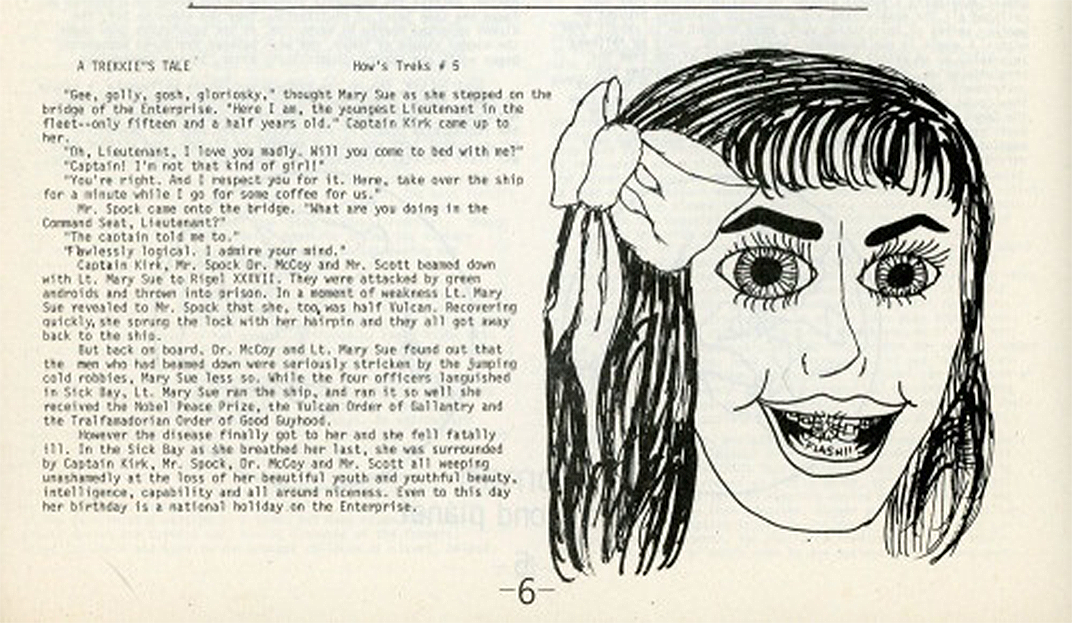
While the original meaning of a Mary Sue referred to a stand-in character of any gender orientation, the reason Smith and Ferraro encountered more Mary Sues than Murray Sues when they were running Menagerie likely had more to do with who was writing in. Unlike the larger science fiction fanbase, which skewed male, both Smith and Ferraro remember that the “Star Trek” fandom they experienced was made up of mostly women. “Science fiction fandom, in general, was like 80 percent men,” Ferraro ballparks. “'Star Trek' fandom was the exact opposite; at least 75 percent women.”
Later, cultural critics began to make the argument that Mary Sues opened up a gateway for writers, particularly women and members of underrepresented communities, to see themselves in extraordinary characters. “People have said [the Mary Sue characters] actually seem to be a stage in writing for many people,” Smith says. “It's a way of exercising who they are and what they can imagine themselves doing.”
Naming the trope also allowed people to understand what they were doing when they set out to write a Mary Sue or Murray Sue character. “In terms of teaching writers a lesson, it was very useful in that people could say, well, that’s really a Mary Sue story. And then they could look at it and decide whether they wanted to change it,” says Ferraro.
While both Smith and Ferraro actively worked to popularize the term within the “Star Trek” fan community, neither expected it to catch on the way it has. “I was absolutely blown out of the water when I Googled it the first time and went, oh, my god,” says Ferraro. Smith agrees, “I am surprised that it held on so long. Many fan words get tossed around and they live for a while and then they die.”
But Mary Sue has withstood the test of time. Both articulate the surreal quality that comes with seeing a name they coined take on a life of its own. That includes the creeping sexism that's become associated with the term. "There were the people who would say anytime there was a female protagonist that’s a Mary Sue," Smith remembers. “It just developed in all sorts of ways."
But she’s found her peace with it. “You can’t control a term. Nobody does after a while,” she says. “It's like children. You raise them and you say, oh my gosh, what's happened here? And off they go, and you're pleased to get a call 40 years later from Smithsonian to talk about them.”
Get the latest Travel & Culture stories in your inbox.
Jackie Mansky | | READ MORE
Jacqueline Mansky is a freelance writer and editor living in Los Angeles. She was previously the assistant web editor, humanities, for Smithsonian magazine.
- Entertainment
- Celebrities
- Ticket Sales
- Promoted: What to Watch on Prime Video
trending now

Dad of Florida cruise passenger, 20, who jumped off cruise ship...

Teen accused of shoving Queens grandmother down church steps...

Taco Bell execs reveal what they order nearly every day: 'It will...

Women's butt sizes around the world revealed — which countries...

CNN contributor blasted for saying OJ Simpson 'represented...

'Wheel of Fortune' viewers slam misleading ‘place’ bonus...

Gay Jewish teen met up with his accused neo-Nazi killer because...

Billionaire In-N-Out heiress claims she went 'toe-to-toe' to keep...
‘he had a dark side’: ‘star trek’ creator’s sexism revealed.
- View Author Archive
- Get author RSS feed
Thanks for contacting us. We've received your submission.

Gene Roddenberry, the late Hollywood legend behind “Star Trek,” wasn’t always the saint that his legions of fans want to believe, a new book reveals.
“He had a dark side,” says Edward Gross, who co-wrote “The Fifty-Year Mission: The First 25 Years” (Thomas Dunne, out now).

A fan might assume Roddenberry’s personal point of view was noble. The original 1960s NBC series made enormous strides, putting women and minorities in key roles. And “The Next Generation” continued to push social boundaries by including even more women and a disabled character.
But the man behind it had become angrier, and his mind had noticeably narrowed, the book claims.
Herb Wright, a writer on “The Next Generation,” remembers a speech Roddenberry, then 67, gave about women during a meeting.
“We . . . don’t want to infer that it would be a better society if women ruled,” Wright recalls him saying. “Because as we all know, women are goddamned c–ts!”
Another “Next Generation” writer, Tracy Tormé, says Roddenberry told him “women will suck the marrow out of your bones.”
Gross suggests decades of studio infighting and struggles for control of the franchise negatively affected Roddenberry’s mind-set.
Share this article:
- The Inventory
The Sexist Legacy in Star Trek ’s Progressive Universe
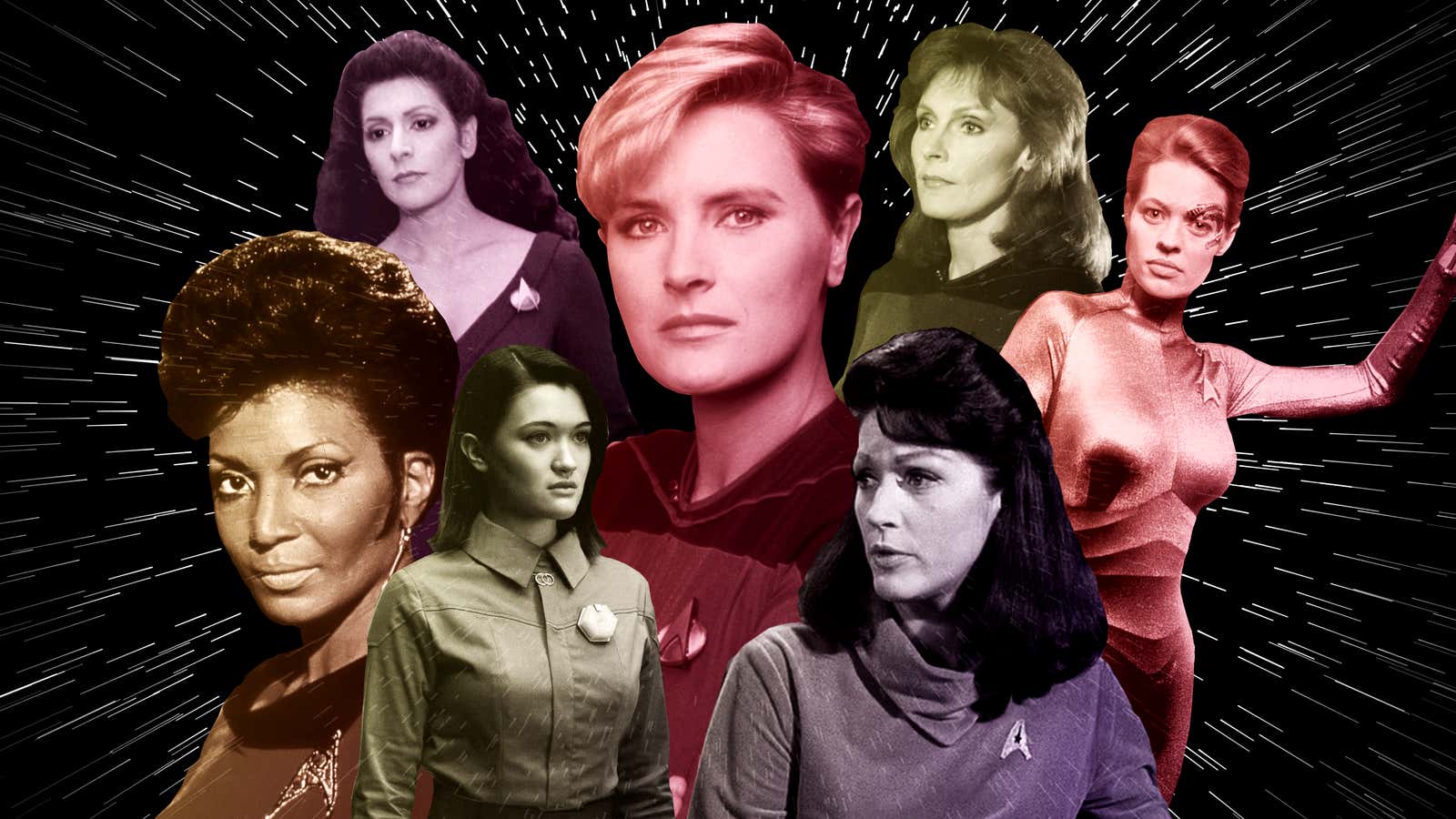
In the fourth episode of Star Trek: Picard , a familiar face storms onto the scene. With plenty of legacy characters, this might just be another day at the (space) office. But this is Seven of Nine, beloved, iconic, even more badass than she was during her time on Voyager —and she was always pretty badass. “You owe me a ship, Picard,” she quips, after saving the crew in a space battle, and the episode cuts to black.
Over 20 years after the USS Voyager returned to the Alpha Quadrant, in Picard Seven is now a hardened vigilante , chucking back whiskey and cursing under her breath. And she has an outfit to match, strutting around in the licensed-badass combination of combat boots, jeans, a loose shirt, and of course, a leather jacket. Gone, finally, is the skintight catsuit that Seven donned on Voyager , a clear invitation to see Seven as a person first, and a woman second — standing in stark contrast to that rib-crushing corset.
With Picard’s Seven of Nine upending her late ‘90s incarnation, we’re forced to confront the stumbles of Star Trek ’s past. In 2020, what can we learn from looking back at Trek —and with all the strides it made for female representation, can we really call it sexist?
A new frontier for women
Women in Star Trek have always had a strong presence, have always been given complex characterizations, and have (ostensibly) been treated as equals by both their peers and the utopian society that surrounded them. Which makes sense, as equal representation was always a core tenet of this frontier-busting space opera. When the very first Star Trek launched onto the airwaves, Gene Roddenberry’s utopian vision led him to position a woman on the bridge—and originally, this wasn’t Uhura.
Star Trek ’s first pilot episode was produced in 1965, and it featured a woman as the first officer. Known only as Number One, Majel Barrett’s character was a commanding presence on the bridge… a little too commanding for test audiences and NBC. According to Roddenberry , it was the women in the test audience that really reacted badly to Number One, thinking her too assertive. When The Original Series was re-conceived with Kirk at the helm, Number One was gone. It would take Trek another two shows, and three decades, to finally cast a woman as first officer.
Without Number One, the women of the original Star Trek were very much of their time. Nurse Chapel (Barrett’s new role) was subservient to Doctor McCoy, and Uhura (Nichelle Nichols), a pioneer of African American representation, nonetheless had far fewer lines than her male counterparts. Speaking to io9, The Next Generation ’s Marina Sirtis (Deanna Troi) is frank in her assessment of Trek ’s female representation. “ The fact that she was on the bridge as a Black woman, was it. They had knocked down so many walls just to put Uhura on the bridge. She didn’t have much to do, but she was there.”
Of course, Star Trek wasn’t just trapped in the ‘60s. By 1986, new life was breathed into the franchise by The Next Generation , whose fresh-faced crew included not one, not two, but three women. These were the compassionate Counsellor Troi, the humanitarian Dr. Beverly Crusher, and the daring Lt. Tasha Yar, who, in particular, was of a new mold. Taking up the traditionally masculine role of security chief, Tasha was inspired by Aliens character Vasquez to emulate the modern woman.
“It was an interesting time, the ‘80s,” said Denise Crosby, who portrayed Yar , getting nostalgic as she describes what made her character a touchstone for the age. “Women were defining themselves not in terms of how they should be perceived, but how they wanted to be perceived.” Crosby identified with this movement, which Gene Roddenberry found refreshing. “Here I was, with this short boy’s haircut, which wasn’t really seen on TV, and he said, ‘I like this! This is a great look.’ So I was part of that wave of change. And I think it was impactful.”
It’s easy to spot echoes of Tasha Yar in other iconic women of sci-fi. From Stargate’s Sam Carter to Battlestar Galactica’s Kara “Starbuck” Thrace, shades of Yar rippled through sci-fi for years to come. Yet, there is an edge of poignancy to why Yar was so significant. Sure, she made waves as a straight-talking woman in a man’s role, but her character impact was both cemented, and cut short, by her untimely death—the circumstances of which we’ll get back to later.
With Yar gone, the women of The Next Generation fit more snugly into classic feminine molds, as Marina Sirtis reminisces. “They got it right, they cast a woman as the security chief. But Denise left, and the two remaining women were in caring professions. So it was ok to be on a spaceship as a woman, but you had to be a nurturer.” Speaking to io9, Gates McFadden (Crusher) is scathing about the few times the women would be thrown together, not to work together, but to gossip. “If the ladies did have a scene together we were dressed up in leotards talking about men. We weren’t sharing opinions on a medical issue!”
Over the ensuing years, Troi and Crusher would slowly get more screen time, as their characters became more nuanced, but they would rarely get the chance to break out of their nurturer molds. And with Crosby gone, security chief wasn’t the only position that needed filling. “I was never supposed to be the chick on the show, the va-va-voom. That was supposed to be Denise,” Sirtis told us. For as progressive as Star Trek tried to be with its women, every show has something in common: There has to be a hot chick.
The Star Trek “babe”
You wouldn’t expect it from a franchise renowned for its socially progressive attitude—and yet every series had its sex symbol. “It was an action-adventure show!” Sirtis remarks dry ly. “There has to be a girl for the boys to look at when they’re not blowing up spaceships .”
So who is the Star Trek babe? She’s got to be young, thin, and pretty. Her outfit will be more form-fitting than the others’, making much of her curves. And of course, one babe trumps them all. This would be Seven of Nine, the ex-Borg who joined Voyager at the tail end of its third season. Elevated on four-inch heels, actor Jeri Ryan was sewn into her catsuit every day, which consisted of a boned corset topped with breast mounds. Truly a feat of engineering.
Even at the time, Seven’s outfit was the cause of much discussion—which is exactly what the network intended. “Seven of Nine is probably one of the sexiest characters I’ve ever seen on TV.” T his was how Conan O’Brien introduced Ryan on his show in 1998, tapping into the precise reason she was added to Voyager . As the audience whooped, Conan asked why on Earth her character would wear such a thing. “It’s medicinal!” Ryan explained, tongue firmly in cheek. Conan quickly retorted, “It’s medicinal for me!”
Seven’s introduction to Voyager was calculated. In the shadow of the hugely influential The Next Generation , and competing with Deep Space Nine , the newest Trek spinoff wasn’t doing as well as the network had hoped. Premiering with over 13 million viewers, Voyager ’s ratings average almost halved to 7 million in the first season, and continued to dwindle. By season three, the average was 4.6. This was a much sharper drop-off than Deep Space Nine , which averaged 8 million viewers across its first four seasons. CBS wanted more from Voyager , and with the inclusion of a new character they saw a chance not just to boost their ratings, but to break into the mainstream.
In the years since, Ryan has described the scores of publicity meetings that were held about Seven of Nine. She was interviewed dozens of times by the media, with her pin-up worthy promo pics splashed across magazines and newspaper supplements—including one particularly memorable crossover with fellow ‘90s genre babe, Xena ’s Lucy Lawless. “It’s always a ratings thing,” Ryan told io9. “And the viewership increased a lot when they added Seven.”
While Seven’s costume continues to be the main talking point—Google her name today and you’ll find hundreds of articles discussing catsuit ethics—Ryan thinks there’s another reason why the character boosted Voyager ’s ratings. “She’s brilliantly written. I think the quality of the show improved because she introduced rich storylines to explore with other characters. It revitalized the show.”
Seven of Nine is the perfect storm, a character that grabs attention with her appearance, then holds it with her story. And it worked. Even today, Seven-centric episodes pull in the most viewers: According to Netflix , the most rewatched Star Trek episodes featured Voyager more than any other show. Of these episodes, all but two highlight Seven’s journey—“Scorpion” is her introduction, “The Gift” features her clashing with Janeway, “Dark Frontier” is all about her connection to the Borg. Even “Endgame,” the show’s finale, features Seven in a pivotal role.

This was why Ryan didn’t mind the catsuit. “I didn’t have a problem with her overtly sexy appearance, many would say gratuitously so, because it was the complete antithesis of the character. She was oblivious to that.” Yet, there is something sinister in this divorcing of Seven from her sex appeal, as it robs her of any autonomy over the sexual attention her costume invites. What would have been different if she were a sexual being, donning the catsuit to be intentionally provocative? Would she still be as beloved?
In reality, Seven’s lack of concern for her appearance allows viewers to enjoy their voyeurship of Seven without feeling uncomfortable. Don’t worry, audiences, Seven only dresses that way because she has no idea what sex is. The catsuit’s medicinal, remember? Seven, an inactive and oblivious participant in her sexualization, tip-toes around the ship in a costume so tight that her actor had to lie down between takes just to get her breath back. And it was the men in her life, both in fiction and behind the scenes of Voyager , who made this decision for her.
The knock-on effects of sexism
All of this seems pretty paradoxical. After all, Star Trek ’s writing of women steadily improved from The Next Generation onwards. Deep Space Nine ’s women broke out of traditional female roles: Kira Nerys (Nana Visitor) was given plenty of screen time as the show delved into her development arc , while Jadzia Dax (Terry Farrell) challenged social boundaries as, arguably, Trek ’s first canonically queer character . But it was Voyager that took female representation one step further, finally featuring a female captain in the lead role. Why, then, did Voyager also feature a woman so objectified that we’re still talking about it decades later? Perhaps Voyager ’s sexism isn’t in spite of its otherwise feminist approach, but because of it.
At the start, Voyager ’s publicity focused on the novelty of a female captain, but as the ratings dwindled, the producers grew concerned that this wasn’t enough to hold viewers’ interest—and perhaps it was putting people off. Interviewed by The Television Academy in 2006, executive producer Rick Berman explained why Seven was added to the show. “We wanted Janeway to be a Starfleet captain, but we also wanted her to be feminine. And those two things don’t go hand-in-hand. If you look at female military officers who make it to the rank of admiral, they tend to not be babes. We cast a woman in her 40s … but we still wanted a feminine woman.”
The addition of a “babe” to offset the feminism of Voyager might have improved ratings, but it put a significant strain on the cast, creating a work environment filled with tensions. Up until Seven’s introduction, Janeway was the clear star of the show, with Kate Mulgrew giving dozens of interviews and appearing on the covers of magazines. Yet, with Ryan came a seismic shift. Now, it was all about this sexy young woman, who was spotlighted as though she were the show’s lead—after all, Lucy Lawless was the star of her own show, and yet that 1999 TV Guide feature presented Lawless and Ryan side-by-side, rather than Lawless and Mulgrew. This caused immense tensions between the two Trek actors.
“In the beginning, Kate’s anger was not directed toward Jeri Ryan, it was directed toward the character,” Garret Wang, who played Harry Kim, told Closer in 2018. “When the producers said no [about getting rid of Seven], Kate kept complaining. Finally her anger was turned toward the actress. That’s when it became horrible.” Mulgrew’s conduct was so stressful that Ryan told Closer she would “feel nauseous” before she arrived on set each day. “I completely understand why. I get it, believe me, but it was very difficult. Overall, this was not my favorite work experience for that reason.”
Even without Mulgrew’s actions, Ryan had enough to deal with just by wearing the catsuit. “If I had to go to the restroom,” Ryan told io9, “it was a 20-minute production break. Everyone had to know over the radio. Someone had to dress me and undress me.” This didn’t just affect Ryan, but everyone on set, as another Voyager castmate (who chose to remain anonymous) commented to Closer. “At one point, Kate pulled the line producer aside and said, ‘Jeri Ryan is not allowed to use the bathroom unless she uses it before work or after work, but not during work. It takes too much time to get her in and out of that suit’.” With work days that often exceeded 15 hours, this obviously wasn’t feasible.
Although costumes are often difficult to deal with, when clothing has been constructed to amplify sex appeal there’s an added strain to that actor’s professional life. No one knows that better than Marina Sirtis. A survivor of anorexia and other eating disorders , Sirtis was under a huge pressure to lose weight in order to maintain her position as The Next Generation ’s babe. She told io9: “I used to get phone calls from the producers telling me I was fat. They’d say, ‘You look fat, and we pay you a lot of money to look good. Think about it.’ I was a stick insect from all the nagging.”
For some of the actors, this toxic environment began before they’d even started shooting, as was the case for Terry Farrell, who played Jadzia Dax in Deep Space Nine . Interviewed for the book The Fifty Year Mission , Farrell revealed that she found her costuming experience with Rick Berman to be very uncomfortable. “He’d comment on your bra size not being voluptuous. He would say, ‘Well, you’re just flat. Look at Christine over there. She has perfect breasts.’” With Berman dissatisfied with Farrell’s body, the costume department was called upon to fix the issue. “I had to have fittings for Dax to have larger breasts. And then I had to go into Berman’s office.”
If the experiences of Sirtis, Ryan, and Farrell teach us nothing else, it’s that the objectification of Star Trek ’s female characters doesn’t just tarnish its ostensibly progressive reputation, it also created a difficult work environment. So in order to judge whether Star Trek is sexist we have to look behind the scenes—and discover what kind of culture leads to these decisions.
The boys’ club
If the entertainment industry is dominated by men now, this was even more the case decades ago. Star Trek has had a few female writers and producers over the years—DC Fontana wrote for The Original Series , The Next Generation , and Deep Space Nine ; Jeri Taylor got her start producing The Next Generation before co-creating Voyager , to name just two immensely influential staffers. But, as Sirtis points out, Star Trek was a franchise created by men: “Even though we were writing a show about the 24th century, apart from Jeri Taylor and Melinda Snodgrass [another writer], the writers and producers were all men. Twentieth-century men. So it’s not gonna be that far-reaching.”
We could argue, of course, that Star Trek was a product of its era, but the actors were aware, at the time, that the show could be better. This aggravated Gates McFadden, as early as season one of The Next Generation , as she revealed to io9. “I wondered, did the women exist for the men to react to? Even Wesley just reacted to his mother, not seeking out her counsel—for counsel he sought out the men on the ship.” Coming from academia, McFadden was used to a collaborative creative environment, but she didn’t encounter that behind the scenes of The Next Generation . “ Jonathan Frakes could bound into the producer’s office and put his feet up, but I couldn’t. That wasn’t acceptable.”
McFadden’s opinions caused conflict with one producer in particular, especially when she pushed the point about Wesley (Wil Wheaton). “That’s when I’d piss the writers off. I’d say, ‘Look, he only goes to the men for advice and he never talks to her.’ I was passionate about it and I alienated that producer,” she said. Rick Berman later named Maurice Hurley as the producer in question—and the tension between Hurley and McFadden reached a boiling point toward the end of season one.
“What I heard is, he said, ‘Either she goes or I go.’” As she revealed to io9, McFadden wasn’t officially given the reason for her firing, but learned the truth later on. “So the choice was made and I went.” When asked about McFadden’s departure, Crosby gave io9 her thoughts on the matter. “Ultimately, it’s the frustration of not being seen and not being heard. No question it’s a gender dynamic, and it’s still happening.”
McFadden wasn’t the only one whose conflict with producers led to an early departure. Toward the end of Deep Space Nine season six, Terry Farrell’s contract was up. Wanting to pursue other projects, Farrell tried to open negotiations for a reduced role in the final season—similar to the contract Colm Meaney (Miles O’Brien) had for the duration of the show. But she clashed with Berman on this issue, as she commented for The Fifty Year Mission .
“He was trying to bully me into saying yes. He was convinced that my cards were going to fold and I was going to sign. He had another producer come up to me and say, ‘If you weren’t here, you know you’d be working at Kmart.’” Recounting the issue for the documentary What We Left Behind , Farrell tearfully protests her character’s exit. “I didn’t want to die! But there was a point where it was like don’t dismiss me! Talk to me.” Ultimately, Farrell was never given the option to renegotiate her contract, so she left the show—leaving Dax brutally murdered in DS9 ’s Bajoran shrine.
Of course, this wasn’t the only time that a woman’s request for contract renegotiations led to her character’s death. The same was true of Denise Crosby, who was frustrated with Tasha Yar’s lack of involvement in The Next Generation season one. “There were so many episodes where I was simply standing on my security position saying nothing. Not engaged with anything. And I thought, I’ll lose my mind doing this for another six years.” Crosby approached Gene Roddenberry, but, as she told io9, he was set against regular storylines that featured anyone other than the captain. “Gene didn’t want to change that, he wouldn’t budge.” Instead, Roddenberry released Crosby from her multi-season contract. “It was good of him. He said, ‘I was your age once, I was hungry and ambitious and I totally get it. You should go for it.’”
Letting an actor out of their contract is one thing. Killing their character so that they cannot return is another. That’s what happened to Yar —but it very nearly happened to a different character instead. “Gene thought we had one too many women on the show,” Sirtis revealed, telling io9 that she was convinced she was going to get fired in season one. As Troi was gradually written out of episodes, Sirtis recalls that producers started avoiding her. “My agent called Roddenberry and said, ‘What can we do.’ And he said, ‘Look, I have to do what’s best for the show.’”
Yet before the ax could fall on Troi, Crosby left the show. “Denise quitting is the reason we’re talking now,” says Sirtis. “She saved my job!” Had Crosby not left The Next Generation , the show would have been very different—and it’s possible that either Troi or Crusher wouldn’t have made it through season one alive. According to Crosby, Roddenberry was eager to kill Yar once he knew she was leaving. “He’d never done it before with one of his regular characters. It would be shocking because it was so unprovoked and so sudden.”
With Sirtis on the rocks before Crosby quit, was Roddenberry planning on killing Troi off instead? Or, would Crusher have been killed when Maurice Hurley gave Roddenberry his ultimatum about firing McFadden? We may never know, but there’s something very uncomfortable about all the tales Crosby, Sirtis, McFadden, and Farrell have to tell, in which a woman went up against the boys’ club... and her character was either killed or shoved out.
How things have changed
That was then. So what has changed in the last few decades? Well, for one thing, Seven of Nine isn’t in a catsuit any more—which Ryan is happy about. “I am delighted beyond words that there’s no catsuit involved [in Picard ]! I think it’s much more appropriate, the way the character’s dressed now, and it’s perfect for what she’s been through.” A far cry from her impractical catsuit in Voyager, Picard ’s iteration of Seven is comfortable and ready for action.
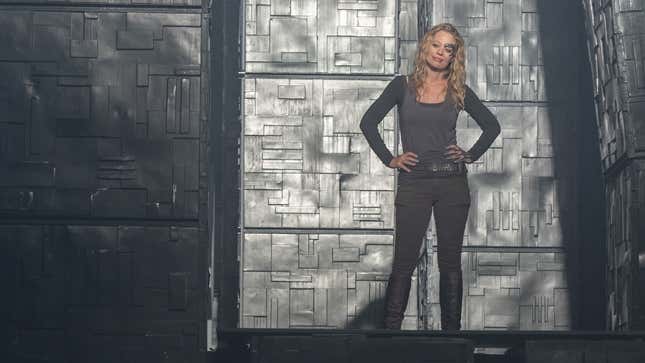
And just like when she was added to Voyager , Seven’s inclusion in Picard lead to a spike in interest and a shift in publicity. But there’s something very satisfying in the fact that she didn’t need to be dressed in a catsuit for this to happen. Much of this is due to the success of her character on Voyager , but this also proves how our attitude to female representation has changed. Now, producers can’t get away with the kind of costume that Seven was squeezed into on Voyager , or the pin-up publicity that invited talk show hosts to openly lust after Ryan to her face.
Of how things have changed Ryan said, “It was a different industry back then, and we’ve evolved. Thank God! Not enough, but we’re getting there.” And McFadden agrees. “When I think of Discovery and Picard , women have evolved so much.” Having fought for better representation when she was on The Next Generation , McFadden is delighted to discover how things have changed in Picard . “These women are characters before their gender. That’s wonderful progress.”
Sirtis, who joined the CBS All Access show for one episode , is likewise impressed. “With Picard we have equality. Old baldy, sorry, sir old baldy, he’s the first on the call sheet, but other than that we’re equal. There are men and women and there’s not a preponderance of one sex over the other.” Though it has a male lead, Picard is remarkably female-driven. In the main cast, Picard has four men and three women, but its recurring cast members feature prominently, and of these, four are women and only two are men. What’s more, there is complete parity of screen time—if anything, women get more screen time than the men.
Isa Briones —newcomer to the show, and television—told io9 she found this approach refreshing. Although initially, she was concerned that her character Soji would be born sexy yesterday . “We could have so easily fallen into that trope, making her this childlike girl who doesn’t know anything, who’s just following men,” she said. Arguably, Seven of Nine fulfills this trope in Voyager , as the childlike outsider who has to be taught how to be human. But Seven is far from this in Picard , as is Soji, the android girl who thinks herself human. Briones told us, “Soji’s going through her own journey to find out who she is on her terms. I think it’s beautiful that you can get characters like that now and you don’t have to put them in skimpy outfits and make them a sex object.”
It’s not just a shift in social perceptions that has led to this change in female representation, there are also better opportunities for women within the industry, as McFadden pointed out: “There are so many more mentors for young women nowadays. I wanted to direct, so badly, and I asked for it in my very first season. And I was not given it.” McFadden would eventually direct only one episode of The Next Generation , while her male peers directed multiple episodes. Frakes, in particular, used this experience to launch a prolific career as a director, proving how powerful these early opportunities can be.
Briones, however, has already found plenty of mentors on the set of Picard , in particular Sirtis, who took the younger actor under her wing. “I was just giving her tips,” Sirtis laughed, “little things that I had gone through that no one told me.” And that is very in keeping with Star Trek ’s tradition of empowering female characters, which we can see even outside the Trek sets. McFadden told io9 how women will approach her with tales of how Beverly Crusher inspired them to achieve their goals, “I’ve spoken to so many female surgeons who tell me Beverly gave them the idea to pursue a career in medicine. Obviously their own perseverance made it happen, but seeing Beverly made a difference. It showed them it was possible.”
But it’s not just about entering the workplace, as Ryan pointed out. “I’ve heard from so many people, on the autism spectrum, in the LGBTQ community, and trauma survivors, who connected with Seven,” she said. “They so appreciated feeling like they saw themselves on screen because they’ve always felt like an outsider. I love that Seven has helped people feel like they’re not alone.” Before Voyager introduced Seven, Tasha Yar was a touchstone for queer people, as Crosby gleefully told us. “People would always ask me, y’know, ‘Was Tasha gay?’ And I think in that century is that really a question that we’re even gonna be talking about? So I always had a little twinkle in my eye about it, and I’d never answer straightforwardly. Straight, gay, bi… listen, she was with an android, what do you call that?”
Although Star Trek has a checkered history of LGBTQ representation, Seven of Nine was implied to be queer in the season one finale of Picard . Ryan is fully on board with this character choice, for much the same reasons Crosby would get that twinkle in her eye. “It always made perfect sense,” Ryan said of Seven’s sexuality. “Because coming from the Borg, that’s the perfect character to explore that with because she wouldn’t have grown up with any societal influences one way or the other. It is what it is, this is who you love, you’re attracted to who you’re attracted to, whatever.”
New to the franchise and excited for her character’s potential, Briones hopes that Soji will similarly be a touchstone for marginalized people. “I really identify with Soji because I’m mixed race. As a mixed kid, you’re often told, ‘You’re not this, you’re not that…’ Soji has felt human her whole life, so how can anyone tell her that she’s not?” Briones believes that it’s important for young people to see Soji going through what they’re going through “in the heightened environment of space!”
Of course, it’s not just Picard that’s fighting the good fight in terms of representation in Star Trek . Although it has a ways to go with its LGBTQ representation, Discovery has blazed another trail through the stars with Sonequa Martin-Green helming the show. Here, again, we find the tradition of Trek ’s women inspiring women, as Crosby reflects on her recent reunion with Martin-Green. “Sonequa said to me, ‘Tasha was the window into the character I’m playing on Discovery . You really gave me an insight into how to play this character.’ And I was very deeply touched.” Considering Tasha’s untimely death, her legacy is poignant. “We’re not leaving it in the past,” she said. “we’re bringing it into the future, this through-line of women. It continues to grow.”
As we reflect on Star Trek ’s history of female representation, we see both objectification and inspiring representation. And now, as more women are writing female characters, side-by-side with men, they’re just people writing people. It goes to show that the more inclusive we are as a society, the more we’ll be able to imagine and build a better future. And isn’t that what Star Trek was trying to tell us all along?
For more, make sure you’re following us on our Instagram @ io9dotcom .
- More to Explore
- Series & Movies
Published Jun 2, 2017
6 Things to Know About "Turnabout Intruder"
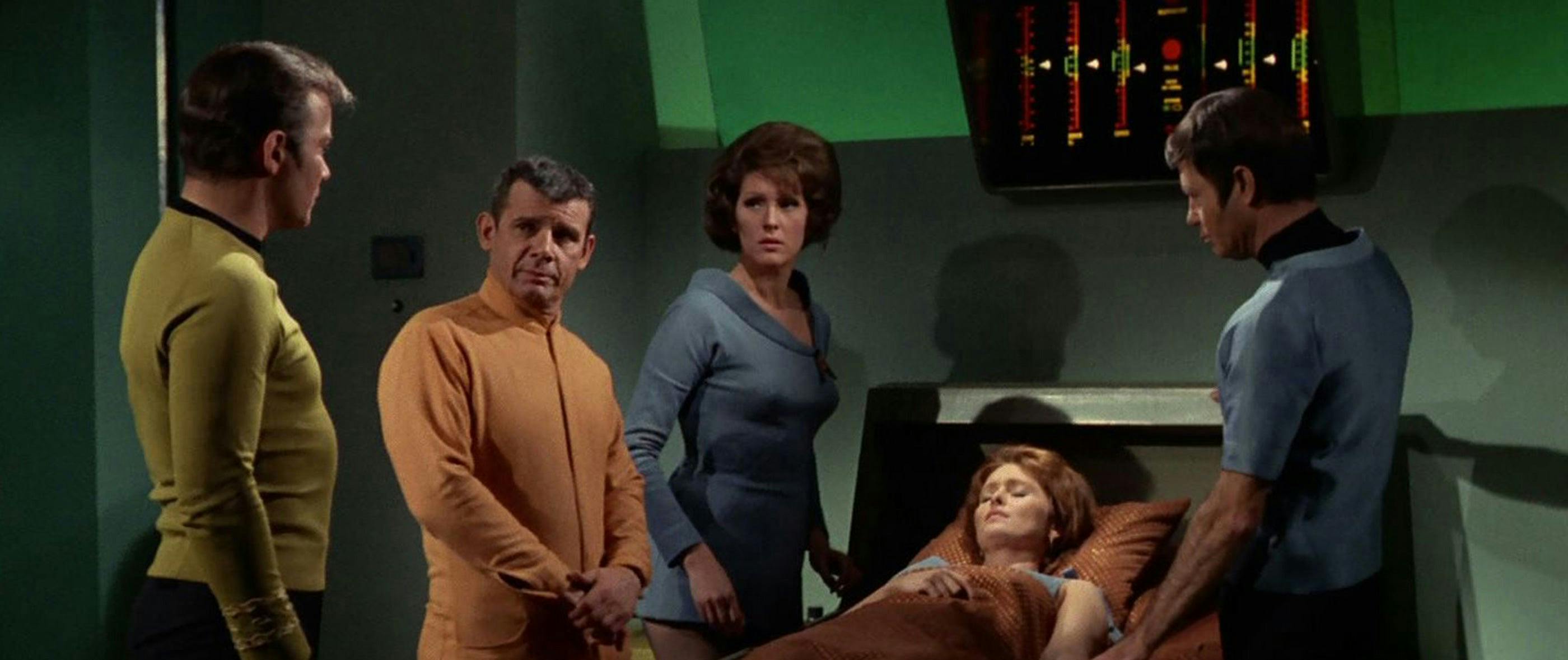
It was, truth be told, an inelegant ending. Star Trek: The Original Series wrapped its run on June 3, 1969 with the episode " Turnabout Intruder ," a mad-scientist hour and, in the view of pretty much everyone, a rather sexist installment for such a progressive series. Still, it holds an important place in Star Trek history and, as such, StarTrek.com shares 6 Things to Know About "Turnabout Intruder."
Wallerstein's Fourth Trek
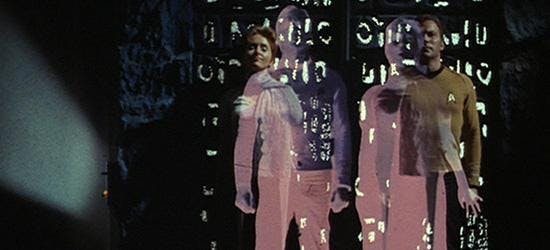
"Turnabout Intruder" was directed by Herbert Wallerstein, who'd earlier helmed " The Tholian Web ," " That Which Survives " and " Whom Gods Destroy ." Sadly, Wallerstein died in 1985 at the age of 59, having been beaten to death by his housekeeper, who claimed she was defending herself.
Roddenberry Written
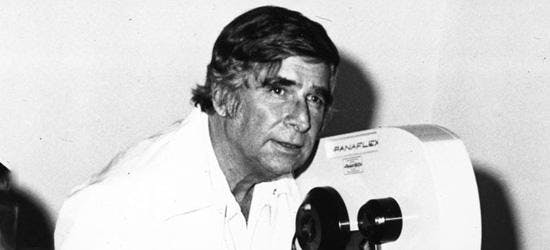
The story outline for "Turnabout Intruder" was tapped out in April of 1968... by Gene Roddenberry.
The LEMLI Connection
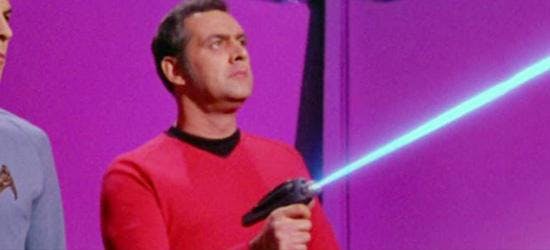
The character of Lemli was played by Roger Holloway. He'd portrayed Starfleet crewman many times before, sans dialogue or a character name or dialogue. He actually spoke two words in the series finale and was named Lemli. No doubt not coincidentally, William Shatner's licence plate back then read LEMLI -- a mix of his daughters' names: Leslie, Melanie and Lisabeth -- and to this day his production company is called Lemli Productions.
Honoring Ike
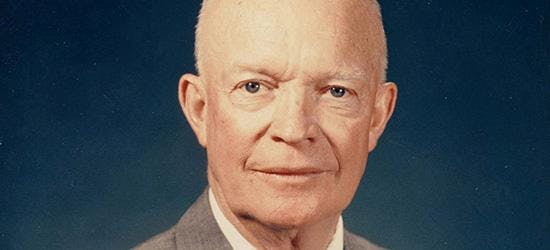
NBC planned to air "Turnabout Intruder" on March 28, 1969. Sadly, former President Dwight D. Eisenhower had died, prompting NBC to bump the episode... to June.
Just Imagine
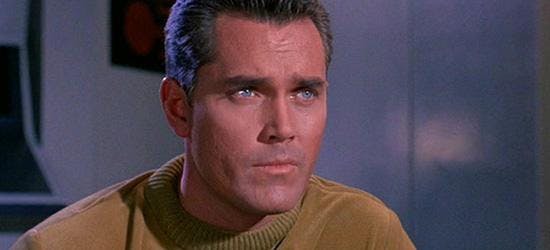
Jeffrey Hunter, who exited Trek after filming "The Cage," died on May 27, 1969, a week before "Turnabout Intruder" premiered. Just imagine how different Star Trek might have been if he'd continued to play Captain Pike. Would there ever have been TOS movies or spinoffs?

In the Next Generation episode " Legacy ," Captain Picard comments that the Enterprise is bypassing an archeological survey on Camus II, precisely where the action in "Turnabout Intruder" started. That was TNG 's sly tip tribute to TOS , as it marked the 80th episode of TNG , surpassing TOS , which ended after 79 episodes.
Get Updates By Email
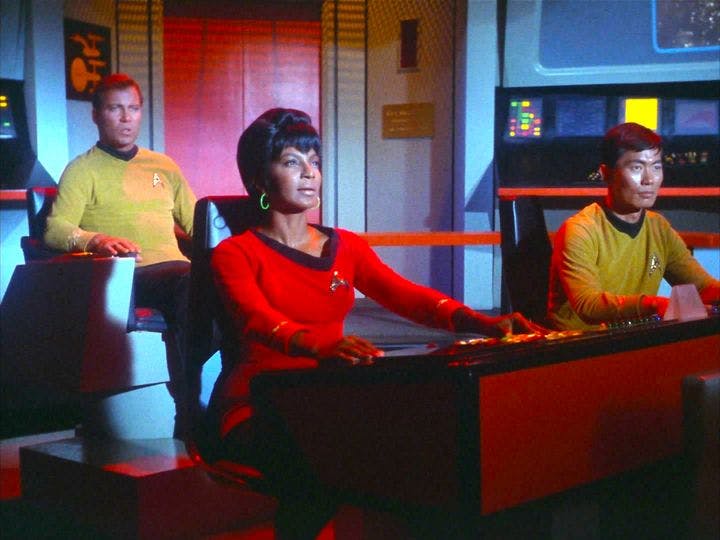
Star Trek's Underappreciated Feminist History
– Shannon Mizzi
Starfleet women were the futuristic version of Helen Gurley Brown’s 'Single Girls' —they did not cook, clean, have kids, or get married. They were competent professionals.
Despite airing for only three seasons — from 1966 to 1969 — Star Trek is widely considered one of the most culturally influential series in American television history. In many ways it was a progressive offering, featuring a multi-racial cast, and male and female characters who worked together as equals. In the years since it went off the air, one criticism it has been repeatedly charged with repeatedly is sexism. In a recent article in Frontiers , Patricia Vettel-Becker contextualizes the position of female characters on the show and examines not whether Star Trek was sexist, but why it portrayed women the way it did.
Star Trek made its debut in the fall of 1966 on NBC. This was its second incarnation; the network had turned down the original pilot for the series, partly because certain female characters had not tested well with audiences. A female character named “Number One” induced a particularly strong reaction. “Not only did men hate the character, but women hated her as well, calling her ‘pushy’ and ‘annoying’ and criticizing her for ‘trying so hard to fit in with the men,” writes Vettel-Becker. Any hint of “masculine” qualities in female characters was strongly rejected by test audiences. The show’s producers were instructed to make some drastic changes if they wanted the show to make it to air.
Some of the biggests changes made were to the characters’ costumes, which had originally been unisex. When Star Trek finally premiered, “the women of Starfleet wore short, close-fitting tunics that emphasized their feminine curves and highlighted their legs, their thighs sheathed in transparent black hose, their calves and feet in snug high-heeled boots.” Vettel-Becker argues that because the women of Star Trek were engaged in an occupation so vastly different from what was socially acceptable at the time — the first female candidates for NASA’s astronaut program were not accepted until 1978 — it was essential that they appear as feminine as possible to quell any social anxieties dredged up by their existence. The costumes and mannerisms of Star Trek ’s female characters, writes Vettel-Becker, “may have soothed anxiety over the possibility of de-feminization by appearing and acting ultra-feminine, overcompensating for their relinquishing of domesticity and their adopting of scientific or technological career fields.” This ultra-femininity was expressed through both clothing and romantic dependence on male characters.

“Starfleet women were the futuristic version of Helen Gurley Brown’s ‘Single Girls,’” writes Vettel-Becker. “They did not cook, clean, raise offspring, or get married … they are characterized as competent professionals.”
The series’ female characters often took on nurturing roles in addition to the duties associated with their occupations. This , it seemed, was what was required to keep American audiences happy while they were experiencing a profound upheaval in gender relations in their daily lives. This was a time when the proportion of women in the workforce was steadily increasing, the women’s rights movement was gaining traction and visibility, and many women felt that marriage and a retreat to domesticity could be postponed or refused in favor of career advancement. The idea of men and women working alongside one another in the workplace made Americans of both genders uneasy.
Although the show is often retrospectively charged with sexism, Vettel-Becker asserts that the women of Star Trek actually constituted strong role models for female fans in the 1960s. “Starfleet women were the futuristic version of Helen Gurley Brown’s ‘Single Girls.’ They did not cook, clean, raise offspring, or get married,” she writes. “Despite the visual objectification of [female characters like] Rand and Uhura, they are characterized as competent professionals.” Female commanders on par with Spock made appearances every so often from rival civilizations. For female viewers, “such characters would be a fantasy projection, a way for them to imagine themselves in such a position — commanding a starship and its crew while enjoying the pleasures of fashionable attire, comfortable furnishings, and sexual companionship on one’s own terms.”
When interviewed in later years, many of Star Trek ’s lead actresses did not see their costumes as demeaning or sexist, saying instead that to them mini-skirts were a sign of sexual liberation rather than oppression. Indeed, young women in the ‘60s were beginning to adopt miniskirts as a fashionable expression of modernity and freedom from the domestic sphere. Many were encouraged by contemporary books like 1962’s Sex and the Single Girl (written by Helen Gurley Brown, who became the editor of Cosmopolitan magazine in 1965 ) to use their femininity to get ahead in the workplace. “A masculine woman will never be taken for a man in a man’s world,” wrote Gurley Brown, “she will be considered a failed woman.” Vettel-Becker sees this theme as omnipresent in Star Trek writing “whether inherent, an act to play, or a mixture of both, femininity was one tool 1960s women had that men did not, and they did not want to lose it. Only one of the two major markers of femininity could be sacrificed, either domesticity or beauty, but not both.” Examined from the vantage point of today’s third-wave feminism, the revealing outfits worn by the women of Star Trek can seem like instruments of objectification, but Vettel-Becker argues that many women viewed them as tools for getting ahead rather than something demeaning that they were forced to wear.
Star Trek retained a loyal female fan base throughout its first run, and women played a great part in the massive letter-writing campaigns that took place before and after its third season, designed to convince NBC to keep the show on the air. Many women wrote fan letters expressing gratitude to the show’s creators saying that the series inspired and encouraged them to pursue careers in technology and the sciences. As Vettel-Becker writes, “although critics have tended to regard the women in Star Trek as little more than sex objects on display for the pleasure of men … I would argue that in Star Trek , beauty functions as a metaphor for humanity, and therefore it is beauty that humanizes outer space, that soothes anxiety over the terrifying unknown.”
The Source: “Space and the Single Girl: Star Trek , Aesthetics, and 1960s Femininity” by Patricia Vettel-Becker, Frontiers: A Journal of Women Studies , 2014.

Sexism and Gender Roles in Star Trek: The Next Generation

Gene Roddenberry regretted how women had been portrayed on The Original Series . He told Cinefantastique not long before his death that, during the first Star Trek ,
I didn’t pay any attention to women. In the years I have grown into something of a strong feminist.
But his desire to portray a future of gender equality led to some absurd overcorrections in the beginning of Star Trek: The Next Generation . It wasn’t until the later seasons that the show became comfortable with femininity.
Good intentions

Whereas Kirk had ventured “where no man has gone before,” Picard’s Enterprise would explore the gender-neutral “where no one has gone before.” More women were involved in creating the show, on-screen and behind-the-scenes. Three of the ten main characters were female: Beverly Crusher (Gates McFadden), Deanna Troi (Marina Sirtis) and Natasha Yar (Denise Crosby). Although two of the three were in traditionally feminine caregiving roles (doctor and therapist), all were included in decision-making aboard the Enterprise and they all had their own unique backgrounds, motivations, strengths and weaknesses. No longer were the women of Star Trek defined by men.
Nor were they the only objects of lust and desire. On The Next Generation , women initiated romantic and sexual relations as well. Yar seduces Data (Brent Spiner) in “The Naked Now”. Troi, not Riker (Jonathan Frakes), sets the boundaries in their relationship. Lwaxana Troi (Majel Barrett) flirted with every man in her sight.
But Roddenberry’s newfound feminism also had clumsy consequences, from the female-ruled planet of “Angel One” — which McFadden described as “one of the most sexist episodes we ever had” — to the “skant”, a unisex version of the old miniskirt.

Troi and Yar wore the skant only once, in “Encounter at Farpoint”. The security chief would appear in jumpsuits for the rest of her tenure. Sirtis was given various dresses to wear over the course of the series until Captain Jellico (Ronny Cox) told her to put on a uniform in Season 6’s “Chain of Command”. Her Season 7 publicity photo is the only one in which Sirtis wears a uniform.
Sirtis was thrilled, telling the BBC :
First of all, it covered up my cleavage and, consequently, I got all my brains back, because when you have a cleavage you can’t have brains in Hollywood. So I got all my brains back and I was allowed to do things that I hadn’t been allowed to do for five or six years. I went on away teams, I was in charge of staff, I had my pips back, I had phasers, I had all the equipment again, and it was fabulous.
But neither she nor McFadden ever wore the same costume as the men.

When Robert Blackman redesigned William Ware Theiss’ spandex uniforms in Season 3 to give the actors more comfort, he created a looser, two-piece outfit for the male actors and a tight jumpsuit for the women. Guest actresses, like Elizabeth Dennehy (Shelby) and Michelle Forbes (Ensign Ro), were shocked at how uncomfortable they were.
“They have stirrups on the feet and big shoulder pads, so it’s like you’re being compressed and pulled together by a rubber band,” Dennehy told Cinefantastique in 1992.
Forbes remembered she thought the costume would improve her posture, but -- “About four hours later, I wanted to rip it off my body.”
Gender roles

Dennehy brought a female character to the show Star Trek hadn’t seen before: a woman who was unabashedly ambitious. Lynelle White, an Air Force pilot turned screenwriter, argues that when the Season 3 finale, “The Best of Both Worlds”, aired in the summer of 1990, “Shelby was the ambitious female boss we desperately needed at the dawn of the new decade.”
Shelby is the embodiment of what a woman can be when not saddled with a pay gap. She’s not forced into the role of “the nice girl” who does all the hard work in the office, yet is repeatedly told to wait for her turn at career advancement. She doesn’t need to fear making her professional goals widely known, lest she be seen as “overly aggressively” by her male peers. She needn’t overthink the perfect moment to interject in a meeting without seeming bossy. Unburdened and unbothered by any of that, Shelby simply goes out and gets whatever the hell she wants.
The series’ female regulars, by contrast, served as nurturers for the crew’s bodies and minds.

Sirtis told Cinefantastique in 1991 that, since Crosby’s departure, the remaining women on the show were “very non-threatening.”
I don’t think it’s realistic. It’s not realistic for the twentieth century, so it’s definitively not realistic for the twenty-fourth century.
Shelby was not a caregiver, and, according to White, “it felt revelatory for a show like Star Trek to acknowledge two simple truths: not all women have the nurturing gene and not all women want to hear your feelings.”
Some women are all-business, and that needs to be normalized the same way it is for male characters.

Jeri Taylor, who joined The Next Generation at the beginning of Season 4, made an effort, lamenting to Cinefantastique in 1993 that Crusher and Troi had been “put in caretaker roles.” She promised there would be stories “that break them out of that mold.”
In “Suspicions”, for example, Crusher goes against regulations to investigate the death of a Ferengi scientist.
In “Descent”, an episode Taylor pitched with Michael Piller, and was written by Ronald D. Moore, Crusher takes command of the Enterprise and defeats a Borg ship while the other officers are stranded on a planet.
“Face of the Enemy” places Troi as a spy aboard a Romulan warship. She attains full commander rank in “Thine Own Self”.
The only woman on the writing staff, Taylor also contributed several multidimensional female guest characters, notably Jean Simmons’ Admiral Satie in “The Drumhead”. Taylor also wrote “The Outcast”, which deals explicitly with gender and transgender issues.

But for every “The Outcast”, there was still a “Qpid”, where Crusher and Troi are reduced to throwing flowerpots at the villains while their male counterparts fight with swords.
Ending sexism in fiction is about more than putting female characters in traditionally male roles; it’s also about showing women who are confident in and with their femininity.

In “Skin of Evil”, Yar thanks Troi for showing her how she could be “feminine without losing anything.” Sara Century believes Troi’s femininity was a key component of The Next Generation .
In a lot of fiction, women’s emotions devour and destroy them. Female empaths and telepaths in particular are frequently portrayed as unstable and prone to losing control. “That’s never the case with Troi.” (With the exception of “The Loss”, although Century argues that Troi losing her telepathic powers made the character more relatable.) She showed viewers that people who are guided by their hearts can have an edge in life.
We live in a society that views compassion as a weakness, particularly feminine compassion. The message that to care is to give up your strength is instilled through media, culture, even in the mechanics of our very language. Allowing yourself to feel the world with one or two degrees less of a protective layer around your heart takes courage, and courage takes power. Like many highly sensitive people, Deanna Troi is regularly underestimated and her importance reduced. Through her patience and understanding, Troi insists that forcing yourself to view the world with empathy makes you a stronger person, not a weaker one.
As The Next Generation drew to a close, Taylor told Cinefantastique in 1994 that its many “loyal female fans” deserved to “see something down their alley.” The final season included “Sub Rosa”, which was entirely about Crusher, and “Eye of the Beholder”, in which Troi investigates the apparent suicide of a crewman.

In the end, the last season scored second-best out of seven in the so-called Bechdel test, named after cartoonist Alison Bechdel. In order for an episode or movie to pass:
- There must be at least two (named) women characters;
- Who talk to each other;
- About something other than a man.
Jarrah Hodge watched all episodes of the first five Star Trek series for The Mary Sue and found that whereas The Original Series had scored a dismal 7.5 percent, almost 45 percent of the episodes of The Next Generation passed the test. ( Deep Space Nine and Voyager would do even better, Enterprise did worse.)
Along with the improved role of women in TNG came increased interest in Trek fandom by female fans. I attended conventions in the late-70s through the mid-90s, and while there were always a few women in attendance, it was when TNG became popular that I began seeing significant numbers of women at conventions — many of them dressed as Troi or Crusher, or just as Starfleet officers. I think that these characters (and the excellent performances by Sirtis, McFadden and Crosby) really paved the way to the much more inclusive fandom and industry we have today.
I prefer The Original Series . I didn’t watch it for the characters, but more for the plot of each episode and most of them really delivered, whereas The Next Generation felt like a Two and a Half Men -type of sitcom inside Star Trek . It was really stupid, the only thing improved was costumes and effects, but I don’t care about those. The original was the best.
Comparing any Star Trek series other than Lower Decks to Two and a Half Men is pretty insulting. Enjoy your rose-colored glasses. The plots of TNG were objectively more nuanced and complex than anything on TOS.
Possibly one of the dumbest things I have read on any forum.
TOS had some of the worst plots imaginable, especially in Season 3. Keep your tantrum-throwing McCoy.
Somebody needs mention “Up the Long Ladder”. Talks about body autonomy rights for use of the Enterprise crew’s genetic material in cloning without consent, then bundles the population of a rescued (racially stereotyped fast-breeding) colony of Irish descent, off to the clone colony to fix their repopulation problems the old fashioned way… Obliging the females among them not only to facilitate multiple sex partners, but also to undergo pregnancy multiple times with them. Pregnancy was and continues to be the foremost health risk for women, never mind emotional impacts e.g. failed ones. Donating genetic material by comparison is painless and risk-free?! Oh and also sexist: it was played like all the male colonists would love sex and babies by multiple women. MASSIVELY SEXIST, why does nobody mention it!?
Submit comments by email .
Star Trek: The Sexist Reason Deanna Troi Was Nearly Sidelined By Gene Roddenberry
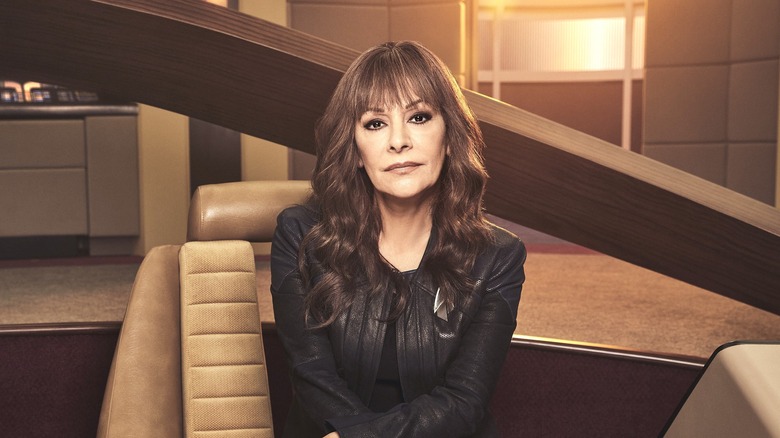
"Star Trek" has always embodied a spirit of egalitarian progressivism, imagining a future of prosperity and equality for all humanity. But even so, it hasn't always managed to hold itself to those lofty ambitions. Marina Sirtis , who played Counselor Deanna Troi on "Star Trek: The Next Generation," can attest to one such lapse that affected her personally.
According to Sirtis, she was nearly kicked off the series due to sexism from none other than the creator of "Star Trek," Gene Roddenberry , and only managed to remain on the cast because Denise Crosby, who played Security Chief Tasha Yar in early seasons of "The Next Generation," voluntarily left the show after Season 1. Sirtis appeared on a panel for Star Trek Las Vegas in 2018 alongside co-star Jonathan Frakes, where she revealed that Roddenberry had seen her character as superfluous due to gender.
"I was very insecure in the first season," Sirtis said (via Trek Movie ), "because they were always writing me out of episodes and I went from being the favorite—because when I was cast, I knew I was their favorite. [Gene Roddenberry] loved me. It was obvious I was their favorite—and it got to the point where if a producer saw me coming, they would turn around and walk away. So, I knew my job was on the line." In fact, it was only because another woman on the show's cast left voluntarily that Sirtis kept her job.
Roddenberry thought there were one too many women on The Next Generation
Marina Sirtis' suspicions that she might be on the chopping block after the first season playing Counselor Deanna Troi on "Star Trek: The Next Generation" were confirmed by none other than Majel Barrett, "Star Trek" creator Gene Roddenberry's spouse who also played Deanna's mother, Lwaxana, on the show. According to Barrett, Roddenberry had been considering writing Sirtis off because he felt there were "one too many women," and would have gone through with it had Denise Crosby not quit her role as Tasha Yar.
Further, Barrett claimed that Roddenberry wasn't sure the Enterprise needed an onboard psychologist because he believed that people in the world of "Star Trek" would have moved beyond interpersonal conflict, making jobs like therapist, psychologist, or counselor unnecessary. Of course, there's plenty of interpersonal conflict on "Star Trek: The Next Generation," whether it's Jean-Luc Picard (Patrick Stewart) facing off against higher-ranking officers or Klingon cultural differences coming between Worf (Michael Dorn) and his shipmates, making it unclear why Roddenberry would have allegedly held that perspective.
The character of Deanna Troi remained on "The Next Generation" for the duration of its seven seasons, and also appeared in the feature films focused on its cast. However, Sirtis was once again nearly fired from "Star Trek: Nemesis," as she also revealed to Jonathan Frakes at the Star Trek Las Vegas panel in 2018 that the production had threatened to replace her with Jeri Ryan, who played Seven of Nine elsewhere in the franchise. But Sirtis said she didn't back down. "I said, 'Well, Jeri Ryan won't do it for that money, that is for sure,'" she told Frakes.
Josh Bernoff
Gene Roddenberry was a sexist pig (and other observations about Star Trek and sex)
I’ve been watching Star Trek (The Original Series) again. Six episodes in, and with the perspective of what we’ve learned in the last five decades, I find its portrayal of women shameful. It says a lot about the way we still think about gender relations and how we got here.
Understand where I’m coming from. I was a child too young to watch the original series when it aired in 1966 to 1969, but became a huge fan in reruns.
By the time I entered college in 1979, it was an article of faith that Star Trek was the preeminent show about the future, a program that challenged our ideas about humanity by viewing them from the viewpoint of a technologically advanced future. In short, it was the epitome of science fiction, and I worshipped at the altar of science fiction. Star Trek’s treatment of race, science, the concept of the alien, and the human soul was like nothing else on television — it led the culture forward. And it was great fun, with great characters and scripts by the world’s best science fiction writers, like Richard Matheson, Norman Spinrad, Theodore Sturgeon, and Harlan Ellison.
I watched those repeats endlessly. As the treasurer of the United Federation of Star Trek Fans at Penn State, I joined my fellow fans in doing whatever we could to bring the show back on the air. I was a true believer in what Star Trek was trying to do and what it represented.
Fifty years since it first aired, and almost forty years since those college days, I took advantage of my subscription to CBS All Access, a subscription I bought only to watch the newest Star Trek series, and decided to watch the original series in the order the episodes were aired.
What were they thinking?
Slowly, unevenly, and not without conflict, our attitudes about the sexes have changed a bit since 1966. So, how did 1966 Star Trek look at women?
This review is based on the first six episodes: “The Man Trap,” “Charlie X,” “Where No Man Has Gone Before,” “The Naked Time,” “The Enemy Within,” and “Mudd’s Women.”
In “The Man Trap,” the crew beam down to perform exams on an archaeologist Robert Crater and his wife Nancy, eventually to find that she has been replaced by a beast that reads minds, can appear as any other person, and preys on and kills people. Within the first two minutes, one of the crew is already being a pig. (I’m grateful to Chakoteya.net for providing all the scripts):
DARNELL: (seeing a young blonde) How do you do, ma’am? KIRK: Something wrong, Darnell? DARNELL: Excuse me sir but, ma’am, if I didn’t know better I would swear you were someone I left behind on Wrigley’s Pleasure Planet. It’s funny, you’re exactly like a girl that . . . MCCOY: A little less mouth, Darnell.
Meanwhile, the only female officer on the bridge is already behaving like a schoolgirl:
SPOCK: Miss Uhura, your last sub-space log contained an error in the frequencies column. UHURA: Mister Spock, sometimes I think if I hear that word frequency once more, I’ll cry. SPOCK: Cry? UHURA: I was just trying to start a conversation. SPOCK: Well, since it is illogical for a communications officer to resent the word frequency, I have no answer. UHURA: No, you have an answer. I’m an illogical woman who’s beginning to feel too much a part of that communications console. Why don’t you tell me I’m an attractive young lady, or ask me if I’ve ever been in love? Tell me how your planet Vulcan looks on a lazy evening when the moon is full.
This is pretty mild compared to what’s coming in the next five episodes.
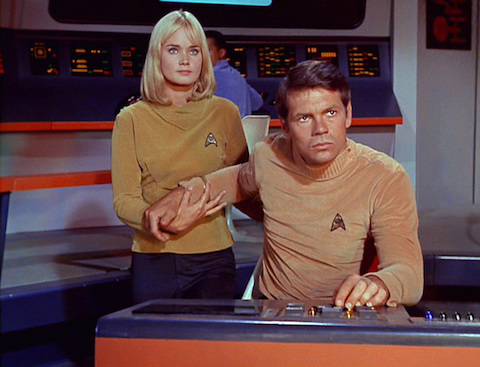
In “The Naked Time,” a disease gets the crew to reveal their innermost feelings. Sulu is a swordsman. Spock is a sentimental philosopher. Kirk is in love with his ship. And Nurse Chapel, of course:
SPOCK: What is it, Nurse? CHAPEL: Mister Spock, (takes his hand) the men from Vulcan treat their women strangely. At least, people say that, but you’re part human too. I know you don’t, you couldn’t, hurt me, would you? I’m in love with you, Mister Spock. You, the human Mister Spock, the Vulcan Mister Spock. SPOCK: Nurse, you should . . . CHAPEL: Christine, please. I see things, how honest you are. I know how you feel. You hide it, but you do have feeling. Oh, how we must hurt you, torture you. SPOCK: I’m in control of my emotions. CHAPEL: The others believe that. I don’t. I love you. I don’t know why, but I love you. I do love you just as you are. Oh, I love you. SPOCK: I’m sorry. UHURA [OC]: Captain is en route to Engineering, Mister Spock. Can you take the bridge? Acknowledge. SPOCK: I am sorry. CHAPEL: Christine. SPOCK: Christine.

But the worst is in “The Enemy Within.” The outlandish premise of this otherwise entertaining and dramatic episode is that a transporter malfunction has split Captain Kirk into two parts, a genial but indecisive Kirk and an evil and paranoid one. Naturally, the evil Kirk gets drunk and goes to the quarters of his beautiful yeoman, Janice Rand (Grace Lee Whitney), where he assaults her.
RAND: Oh! Captain, you startled me. Is there something that you . . .? Can I help you, Captain? KIRK: Jim will do here, Janice. RAND: Oh. KIRK: You’re too beautiful to ignore. Too much woman. We’ve both been pretending too long. (grabs her) Stop pretending. Let’s stop pretending. Come here, Janice. Don’t fight me. Don’t fight me, Janice. (kisses her) RAND: Captain! KIRK: Just a minute, Janice. Just a minute! (forces her onto the floor, she scratches his face and gets away to the door which opens just as Fisher is passing by) RAND: Call Mister Spock! Call Mister Spock!
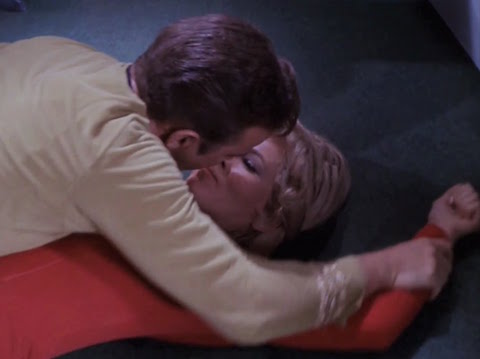
Gene Roddenberry and the male gaze
Star Trek creator Gene Roddenberry wanted his new show to succeed. His philosophy reflected and expanded his fairly typical attitudes about sex. He and his writers created female characters in professional roles like bridge officer, psychiatrist, and historian. But in case after case, these women reveal that their only actual role is to be objects of desire for the males in the crew. The idea of a professional woman being satisfied just being a professional is absent. All the women wear short skirts, and leering and even assault are constant.
Yes, this is a product of the times in which this was created. But Roddenberry’s Star Trek challenged our ideas about race, freedom, leadership, and war. In the original series, he failed to do the same with gender. Women in Star Trek are maidens in distress.
Things matured in the rest of the series, but it remained dedicated to the “ male gaze ,” presenting women on screen for the enjoyment of men.
The subsequent Star Trek series were better. But Roddenberry’s original series remains a testament to the sexist attitudes of the 60s.
How does this bear on all the harassment accusations we new see?
I’m not blaming Star Trek for all the harassers out in the world now. They are responsible for their own actions.
But consider how media, like Star Trek, normalized their attitudes. If you grew up in the 60s, the boss chasing his secretary around the desk was a trope. Every woman in the workplace had to deal with attitudes just like what I’ve described here. And every man who even considered such actions viewed media like this and said, “See, that’s the way the world is.” If there was a moment to consider a woman from a more human perspective, and not as prey for the male predator, this media helped ensure that the moment would pass without additional reflection.
My own journey to awareness has happened over years of interacting with professional, intelligent women in the workplace and socially. I had plenty of sexist attitudes, and it’s interesting to me to view these episodes from the perspective of many decades and realize how far my attitudes have come — how what once seemed totally normal to me now seems completely wrong.
No one who harasses a woman can use this as an excuse. But I’d like to see today’s film and television artists create some art that undoes the sexist attitudes of the past — the pernicious attitudes that their peers have so effectively supported and contributed to.
Leave a Reply Cancel reply
This site uses Akismet to reduce spam. Learn how your comment data is processed .
16 Comments
Star Trek was definitely in my friends’ Geek Wheelhouse, but never made sense to me. This is why.
As a Trekkie, I do appreciate the idealism of the universe created by Gene Roddenberry. The sexism in the original series is palatable. As much as women were still objectified in everything from their roles to their uniforms and costumes, they were still significantly ahead of the contemporary women. Having a woman, much less a black woman, as communications officer was unthinkable in the late 50s and even mid-60s, yet they broke that barrier. While you raise good points about the show’s presentation of women, you overlook or bypass the behind the scenes issues with Roddenberry. He was a philanderer of the highest order. He was having affairs with both Nichelle Nicols and Majel Barrett while married to his first wife, Eileen-Anita Rexroat. So, we can see that sexual harrassment and inappropriate behavior was happening in the 20th and 23rd centuries — in front and behind the cameras.
I was aware of Roddenberry’s behavior. But I chose to focus on the impact of his art rather than his personal behavior.
Being a philanderer does not make one a sexual harasser. People need to stop policing adultery. That has absolutely nothing to do with actual harassment.
Roddenberry was the employer of these women and bragged about abusing his power. Stop defending an obvious pig.
Exactly. It is an inherently unequal relationship when it involves an employer and an employee, and that is why such relationships are considered inherently improper.
Please Spock, don’t say it’s fascinating.
No. But it is interesting.
JC in a baggy! Dig up all the dead, tear their bones apart and of course forget what they gave us! After all we are in the 21st Century and we are all knowing and righteous!
His original pitch had a female captain. He also wanted strong female roles but the network rejected it because they thought it wouldn’t be believable. This was a time when women were still thought of as being inferior.
You’re letting the rest of the history of Star Trek go free? Come on…
Sure, the science or plots were more intriguing as science and technology advanced decade after decade, but the franchise is still stark misogynistic; most don’t even realize that or care to recognize it, I am afraid…
…. so tell me one time when any actress + character in the franchise, at one time or another, did not to submit to, willingly or unwillingly, to the ogling and voyeurism of its fans either on the scree of Trek, or elsewhere, either to get noticed or to make cash with their fame?
It’s the same old b.s. just more advanced every on turn.
Sex sells but selling one’s self short will make one to come up short in the end, and, yes, all good things, our lives included must come to and end and logic dictates that we have to be personally accountable to the morality that we are using to lead us to these final ends … this brings us back to the topic about Gene.
“All the women wear short skirts”
You have to be careful about how to interpret this. Originally, Yeoman Rand, portrayed by Grace Lee Whitney, was supposed to dress in the same manner that the women had in the two pilots, with a loose gold-colored tunic and black trousers. But Whitney complained to Roddenberry that this wouldn’t allow her to show off her “dancer’s legs,” so a short skirt was designed for her and became the norm for female crew members. Therefore, you could justly say that it was more “female vanity” than “sexism” that led to all the crew women wearing short skirts. You also have to recall that in the ’60s miniskirts were very “in” and were considered to symbolize female liberation. Later, attitudes tended to change and to associate such short skirts more with “sexism” and “exploitation” and “the male gaze.” So, again, you have to be careful about interpreting aspects of the show like this, in light of what actually happened and what the cultural attitudes of the time were.
I want to propose a different perspective. I think Star Trek parodies sexism. Some of the scenes, like the one you mentioned with Uhura about being an illogical woman, seem all to aware of their sexist implications. It’s hard to tell, but sometimes I get the sense that it’s constantly sort of making satire of the times, doing it so subtly that everyone watching back then just thought it was natural sexism because they didn’t think twice about it.
Geeeeze… Can’t even look up favorite shows from childhood without these “woke – Nazi’s” trying to ruin yet another great artist and innovators name. These knuckleheads are also doing it up here in Davis California, right now, trying to remove/destroy a beautiful bronze sculpture of Mohandas Mahatma Gandhi.
As a male Bernie Supporter, I gotta tell you, this type of hypocritical, backwards looking baloney is why Trump, (the orange idiot), won the first time, and exactly why he’s going to win this November. People are done with the so-called “woke” Nazi’s who are judging everyone for this and that, playing the perpetual victim, and doing it from their safe spaces online, or on a university campus like mine.
Roddenberry was awesome, an genius, and did more in his life for women’s lib and human rights than every dummy put together on this website. Your article isn’t even put together well, and does not define a cogent argument, just whining.
Well… I’m gonna go watch a rerun of the old Star Trek and check out Uhura. Nice job to the casting agents of the original Star Trek, Uhura was a HOTTIE!!!
Before or after he became a heavy alcoholic?
TNG was worse, though it depends on what you consider bad and or worse. The original script portrayed most of the bridge crew as queer, with betazoid’s having four breasts makes one wonder how we ended up with Wesley Crusher or Riker’s Beard.
Funny fact: The original Trek used the ‘N’ word aimed at Ahura in that episode with Abe Licoln.
Its fun to look at history through current lenses. Maybe they weren’t what you think of them today?
Oh look a debate troll!
“A lens is a fixed piece of equipment meaning you can only see one angle of an image at a time assuming its not distorted you might just have bad eyesight.”
PDF Download
- Enter your name & email to download this pdf.
- Name First Last
Submitting this form will also add you to the WOBS mailing list.
- Name This field is for validation purposes and should be left unchanged.
Set Phasers To Bone: Star Trek Shows, Ranked By Sexiness
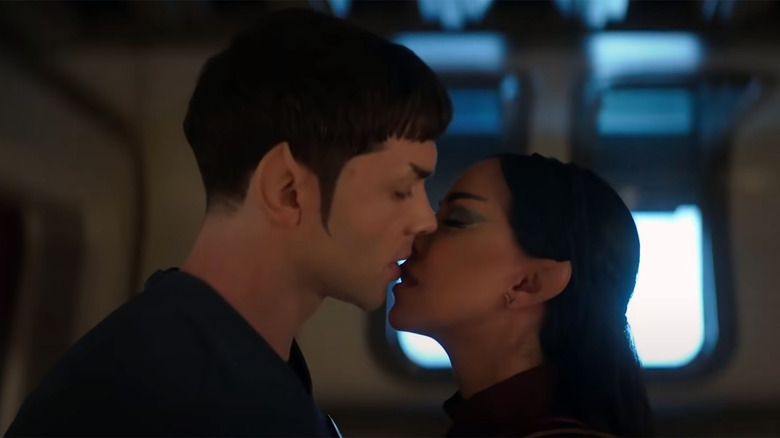
Anyone who's ever watched an episode of "Star Trek" knows that space wasn't the only frontier they were exploring. The franchise is wonderfully horny, from its hormone-driven Captain Kirk (William Shatner) in the early days all the way to Spock (Ethan Peck) having a passionate (by Vulcan standards) love affair with his fiancée on "Star Trek: Strange New Worlds." In celebration of the debut of "Strange New Worlds" and its proper appreciation for keeping "Star Trek" sexy, I've put together a ranking of all of the "Star Trek" shows, from least sexy to sexiest. " Strange New Worlds " hasn't been out long enough to make the list, but if the five episodes made available to critics are any indicator, it'll be close to the top.
Sexiness is relative and subjective, so this list is ranked by judging overall cast sex appeal, diversity and quality of romantic story-lines, and how frequently the series shows its characters getting down. While each of the "Star Trek" series is sexy in its own way, some are just better at the salaciousness, balancing camp and some silly sexuality with the franchise's heavier, allegory-driven output. Series creator Gene Roddenberry included sexuality from the beginning, but every iteration since has taken its own path.
So, which series is sexiest? See how your favorites pan out below.
9. Enterprise
How can "Enterprise" be the least sexy, you say, when it was the show that tried the most desperately to be sexy? Well, just that. "Enterprise" is chock-full of naked flesh and see-through shirts, but it all feels so weirdly exploitative that it's never actually very hot. The hotties of "Enterprise" are all lovely to look at, but their sexual exploits never really seem like much fun. T'Pol (Jolene Blalock) is the focus of most of the series' sexual escapades, including an episode where she goes into an uncontrollable sex-craze due to Pon-Farr, the Vulcan mating cycle. (Think of it like a cat in heat.) The costumes are also all skin-tight, the crew gets naked pretty regularly, and the camera follows people's most sexually appealing parts more than you see in other "Star Trek" series. I don't even think of it as the male gaze so much as the Rick Berman gaze, objectifying every woman onscreen and the occasional man for good measure. Berman has a long history of treating the women of "Trek" like objects and he co-created "Enterprise," so there's not too much surprise that it's as voyeuristic as it is. It's really too bad, too, because series captain/hot dad Scott Bakula looked pretty good in a Starfleet uniform.
Sexiest moment: In the season 3 episode "Damage," T'Pol has a wet and wild shower sex scene with Chief Engineer Tucker (Connor Trinneer), though it is eventually revealed to only be a hallucination as a result of her withdrawal from a Trelium-D treatment.
While it's impossible to deny the incredible hotness of Jeri Ryan, who plays the former Borg Seven of Nine , "Star Trek: Voyager" just really isn't all that sexy. Perhaps in an effort to stand apart from the character-driven "Deep Space Nine," "Voyager" didn't really give its crew many romances or even opportunities for casual hookups. Sure, Captain Janeway (Kate Mulgrew) slept with the enemy in season 5 and there was an annoying "will-they/won't they" situation with Chakotay (Robert Beltran) and Seven of Nine, but beyond the simple ogling of women in spandex that always comes with '90s "Trek," there just isn't much to get the engines going.
Sexiest moment: Chakotay and Seven of Nine had one deliciously spicy moment, but unfortunately, much like T'Pol's shower scene on "Enterprise," this one also didn't actually happen. While trying to reconcile her romantic feelings for Chakotay, Seven of Nine recreates him on the holodeck and they end up getting hot and heavy. This complicates things in the real world for poor Seven of Nine, whose feelings for Chakotay are so strong that her brain shuts itself down as a protective mechanism left over from her Borg programming. Then again, if his smoldering eyes ever gazed my way, my brain might shut off, too.
Once more, the sexiest thing about the series is Jeri Ryan, though her season 2 romantic subplot is chaste to the point of being non-existent. She's also not stuck in the awkward "Voyager-era uniform, either, and seems more comfortable in her own skin. "Star Trek: Picard" isn't all that focused on sex or sexuality, though the eternally simmering hotness of Sir Patrick Stewart cannot go without being mentioned. A man who enjoys good wine and understands the nuances of time travel? Meooww. Season 3 is bringing back the rest of the "Star Trek: The Next Generation" cast, too, which means there will be even more silver-haired hotness to enjoy.
Sexiest moment: The existence of Seven of Nine and Picard, basically.
6. Lower Decks
"Lower Decks" is an animated comedy series, so it's not exactly trying to be all that sexy. There are some fun flirtations and a few sex jokes here and there among the crew that work the lower decks on a mostly forgotten starship, but overall, things are relatively chaste or are played for laughs. Ensign Rutherford (Eugene Cordero) even misses out on the chance to bone down with his date because he's too interested in weird technical minutiae. The crew of the Cerritos are voiced by plenty of sexy people, but their animated counterparts are hindered by the show's animation style, which simplifies everyone's features and highlights silliness. That is, except for one very special guest appearance.
Sexiest moment: I don't know if it's just that Johnathan Frakes is attractive across all mediums or if they did something special while designing cartoon Will Riker, but yum. Utilizing only a handful of hard lines and a very limited color palette, they somehow managed to make the man who can never sit correctly a total hottie in two dimensions. Well done.
5. The Animated Series
Like "Lower Decks," "Star Trek: The Animated Series" is animated and not really trying to be all that sexual, at least most of the time. There are two notable exceptions, however, and one of those is sexy enough to get a leg up on "Lower Decks." In an episode called "Mudd's Passion," Nurse Chapel tries to use love crystals on Spock in order to get some Vulcan lovin', which is a pretty gross attempt to basically space-roofie the poor man. Thanks, 1970s. Thankfully, there's also an episode called "The Lorelei Signal" where the male away-team members end up entranced by hot alien sirens and Lt. Uhura (Nichelle Nichols) has to save their sex-stupefied behinds.
Sexiest moment: The men falling under the spell of the beautiful, Barbie-esque sirens is pretty great. It's the kind of thing that would go on to be spoofed in other shows, like the " Futurama " episode "Amazon Women in the Mood."
4. Discovery
"Star Trek: Discovery" is a mixed bag of sexiness. On the good side of things, there's an incredibly diverse cast of hotties that are getting between the sheets in all kinds of ways. There's an actual romantic relationship between two men, after all, and the series was the first to depict a same-sex masculine kiss in the franchises' long history. There's trans and non-binary characters ! Perhaps most importantly, the mirror universe version of Michelle Yeoh's character, Philippa Georgiou, is a pansexual who has a threesome with a man and a woman in season 1. If "pansexual Michelle Yeoh" doesn't get your heart racing, I'm not sure what will. Unfortunately, points have to be removed for the episode "Into the Forest I Go," which depicts sexual assault in a bizarrely "titillating" way.
Sexiest moment: Most of the sex on "Discovery" is only hinted at, or is just a bit of love between romantic partners, but again: evil mirror universe threesome.
3. The Next Generation
Alright, now we're getting into truly sexy "Star Trek" territory. "Star Trek: The Next Generation" gave the crew of the Enterprise under Captain Jean-Luc Picard (Patrick Stewart) plenty of chances to bone down with each another, aliens, and even a ghost. Unfortunately there really isn't much LGBTQ+ representation, and the one chance the series had to really explore a character's potential bisexuality was frustratingly not taken , but otherwise there's plenty of wild interstellar interspecies action. "The Next Generation" taught us about the intricacies of Klingon mating rituals when Q tried to give Worf a female mate, advocated for polyandry in certain situations in "Up the Long Ladder," and introduced us to the character of Lwaxana Troi (Majel Barrett, who played the original Nurse Chapel in "The Original Series"), who might be the horniest character in all of "Star Trek." Seriously, this woman is thirsty , and has no qualms stroking a Ferengi's lobes or hitting on Odo (Rene Auberjonois) on "Deep Space Nine" until he wants to stay a puddle forever. Instead of punishing her or chastising her for her sexuality, however, "Star Trek" made her into everyone's favorite horny space aunt and let her be herself. (The fact that she was married to Gene Roddenberry, who cast her as the demure Nurse Chapel, honestly makes her onscreen flirtations that much funnier.)
One of the series' wildest sexy moments happened in season 7 with the infamous episode "Sub Rosa." In that episode, Gates McFadden's Dr. Beverly Crusher attends the funeral of her grandmother only to discover that the women in her family have been haunted by a hot ghost for generations. It turns out that there's a special candle that can wake the ghost, and Crusher lights it. She and the ghost then get it on, and it turns out that he's some kind of alien ghost who uses the candle as an energy source to survive on. Their romantic entanglement is a funhouse mirror to the scene in "Ghostbusters" where Dan Aykroyd similarly tangles with the erotic undead, though it's not played for laughs.
Sexiest moment: In season 1, episode 3, "The Naked Now," there's an infection that lowers the crew's inhibitions and is spread by physical contact. The episode was an expansion of the events from an Original Series episode called "The Naked Time," though "The Next Generation" got decidedly more naked in its episode. Under the effects of the infection, Tasha Yar (Denise Crosby) starts looking for someone to have sex with on the ship, though she eventually sets her sights on Data (Brent Spiner), the ship's android crew member. She asks him how "functional" he is sexually and he replies that not only is he "fully functional" but he's programmed with a variety of pleasurable techniques. The two do the horizontal tango, inspiring android fetishes everywhere. Data's sexuality would be further explored in the movie "Star Trek: First Contact," where he has a complicated affair with the Borg Queen (Alice Krige). Is it weird? Yes. Is it hot? Undoubtedly.

2. The Original Series
"Star Trek," now known as "Star Trek: The Original Series," is the one that started it all. The series debuted in 1966 and starred a whole bunch of hotties in skintight costumes, gallivanting about space and meeting even more space hotties. While the original series was never allowed to get as explicit as some of the later shows, there's still plenty of sex appeal and references to sexuality peppered throughout. In fact, Captain James T. Kirk (William Shatner) has such a habit of sleeping with women who pop up throughout his adventures that Dr. "Bones" McCoy laments it by the time we reach the movie "Star Trek VI: The Undiscovered Country. When Kirk hooks up with a shapeshifter on the prison planet Rura Penthe, Bones grumbles "What is it with you, anyway?"
Because it's a series from the 1960s, there are plenty of skimpy skirts and shirtless men to gaze upon, and the series did break ground for showing an interracial kiss in primetime between Kirk and Lt. Uhura, only a year after interracial marriage was deemed legal by the United States Supreme Court. "Star Trek" has always been about progressive ideals and pushing boundaries, and the show pushed for more progressive love and sexuality from the very start. While there aren't any explicitly queer characters on the original series, many fans felt that the relationship between Kirk and Spock (Leonard Nimoy) was more than just a deep friendship. They were a true odd couple , the passionate human and the logical half-Vulcan, and even though the series never made them officially romantic, Roddenberry famously had no problem with the stacks of fan-fiction written to make it so.
Sexiest moment: In the episode "Amok Time," we're first introduced to the idea of Pon-Farr, where Vulcans must mate or they go mad. Spock starts acting really strangely and Kirk tries to help, but the two end up forced to battle with bladed weapons. There's homoeroticism, Spock being wildly horny, and it's hinted that Spock and Nurse Chapel hooked up off screen. It's a perfect mix of all things horny in Trek, and it's a lot of fun, too.
1. Deep Space Nine
Here we are at last, at the sexiest "Star Trek" series of all time: "Star Trek: Deep Space Nine." While I am admittedly biased towards this series because it helped me process my own sexuality and gave me queer role models , "Deep Space Nine" is just ridiculously sexy. The series focused on the interpersonal dynamics of the crew much more than previous series, which made some fans feel like it was a "soap opera in space," but that attention to character relationships was what really made the series sing. Every character was given a chance to explore their identities, and that almost always included their sexuality. "Deep Space Nine" explored a number of relationships, each of them with their own unique twist. Captain Sisko (Avery Brooks) and Kasidy Yates (Penny Johnson Jerald) had to learn how to balance their careers with their romance. Kira Nerys (Nana Visitor) and Odo (René Auberjonois) had to figure out love between a former terrorist with PTSD and a shapeshifter exiled from his people. Worf (Michael Dorn) and Jadzia Dax (Terry Farrell) have perhaps the most loving, healthy, hot relationship in the series, despite being a joined Trill and a Klingon raised by Russians. There are multiple lesbian makeout sessions, and Garak (Andrew Robinson) and Dr. Julian Bashir (Alexander Siddig) have a homoerotic friendship to put Kirk and Spock to shame. Everyone's hot, everyone's humping, and it all plays into their complex relationships.
Sexiest moment: "Deep Space Nine" really goes wild with the mirror universe, letting the actors who play some of the more repressed characters unleash their inner campy horny selves in their doppelgänger counterparts. The alternate version of Kira is an oversexed villainess who slinks around and tries to seduce the other version of herself because, hey, why not? When Sisko ends up in the mirror universe, he not only hooks up with the dominatrix-esque Mirror Kira, he also bones Mirror Dax. It's more than a little ethically fuzzy because both of them think he's Mirror Sisko and not Prime Sisko undercover, though both women are totally unphased when they discover that they slept with a different Sisko.
Watching Mirror Kira strut her stuff and act like a Bond villainess turned up to 11 is not only an incredible amount of fun, it's also pretty darn sexy. Visitor seems to be having a blast acting the part, and the other actors similarly lean in to being deliciously devilish villains. If the crew of "Deep Space 9" are among the hottest in all of Trek, their mirror counterparts blow everyone else out of the competition.
- Cast & crew
- User reviews

In the 23rd Century, Captain James T. Kirk and the crew of the U.S.S. Enterprise explore the galaxy and defend the United Federation of Planets. In the 23rd Century, Captain James T. Kirk and the crew of the U.S.S. Enterprise explore the galaxy and defend the United Federation of Planets. In the 23rd Century, Captain James T. Kirk and the crew of the U.S.S. Enterprise explore the galaxy and defend the United Federation of Planets.
- Gene Roddenberry
- William Shatner
- Leonard Nimoy
- DeForest Kelley
- 277 User reviews
- 99 Critic reviews
- 16 wins & 31 nominations total
Episodes 80

Photos 1964

- Captain James Tiberius 'Jim' Kirk …

- Mister Spock …

- Lieutenant Leslie …

- Nurse Chapel …

- Ensign Freeman …

- Yeoman Rand …

- Announcer …
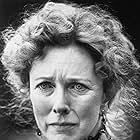
- Beta 5 Computer …
- Security Guard …
- All cast & crew
- Production, box office & more at IMDbPro
Stellar Photos From the "Star Trek" TV Universe

More like this

Did you know
- Trivia In the hallways of the Enterprise there are tubes marked "GNDN." These initials stand for "goes nowhere does nothing."
- Goofs The deck locations for Kirk's Quarters, Sickbay and Transporter Room vary (usually between decks 4-7) throughout the series.
Dr. McCoy : "He's dead, Jim."
- Crazy credits On some episodes, the closing credits show a still that is actually from the Star Trek blooper reel. It is a close-up of stunt man Bill Blackburn who played an android in Return to Tomorrow (1968) , removing his latex make up. In the reel, He is shown taking it off, while an off-screen voice says "You wanted show business, you got it!"
- Alternate versions In 2006, CBS went back to the archives and created HD prints of every episode of the show. In addition to the new video transfer, they re-did all of the model shots and some matte paintings using CGI effects, and re-recorded the original theme song to clean it up. These "Enhanced" versions of the episodes aired on syndication and have been released on DVD and Blu-Ray.
- Connections Edited into Ben 10: Secrets (2006)
- Soundtracks Star Trek Music by Alexander Courage
User reviews 277
- Nov 25, 2003
Lovable Creatures: Our Favorite Screen Pals

- How do they maintain Gravity on the the U.S.S. Enterprise ? .
- All aliens on all planets speak the English language?
- What does "TOS" mean?
- September 8, 1966 (United States)
- United States
- Star Trek: The Original Series
- Backlot, Culver Studios - 9336 W. Washington Blvd., Culver City, California, USA
- Desilu Productions
- Norway Corporation
- Paramount Television
- See more company credits at IMDbPro
Technical specs
- Runtime 50 minutes
Related news
Contribute to this page.
- IMDb Answers: Help fill gaps in our data
- Learn more about contributing
More to explore

Recently viewed

Why 'Star Trek: Discovery' deserves more credit as a barrier-breaking series
Starship Discovery will soon be ending its mission, and what a journey it's been.
“Star Trek: Discovery,” which premiered in 2017, is entering its fifth and final season Thursday on Paramount+. And you’ll need the Captain’s Log to remember all the twists, turns and transformations the show has gone through since it began.
One thing that hasn’t changed, though, is the hate the series has received from some Trek fans. (“Discovery” has an overall audience score of 37% on Rotten Tomatoes, a stark difference from the 87% critic rating.)
Start the day smarter. Get all the news you need in your inbox each morning.
While the show is far from free of legitimate criticism, many of the complaints seem unfairly – though perhaps tellingly – placed on the show’s focus on a Black woman commander, its LGBTQ+ stars and allies and its inclusive storylines. “Woke agenda” and other dog whistles frequently surface on Reddit and social media posts about the series.
That so much of the negativity is rooted in a backlash against inclusivity raises questions. After all, the "Star Trek" franchise has long emphasized and celebrated culture, diversity and humanity coming together and preserving the integrity of beings they meet across the galaxy.
"It doesn't make any sense, because (these fans) say they love this franchise," series star Sonequa Martin-Green says in an interview. The show “has always been about breaking those boundaries. It's always been about diversity and equality. And our world has changed since the last iteration of 'Trek.' We have a responsibility to push that needle forward and to stay true to that."
More: Issa Rae says Hollywood needs to be accountable. Here's why diverse shows are so important
The series is originally set before the events of NBC's original “Star Trek: The Original Series” (later jumping to the future) and follows Michael Burnham (Martin-Green), who became the starship’s captain, and the rest of the crew of the USS Discovery: first officer Saru (Doug Jones), chief engineer Paul Stamets (Anthony Rapp), lieutenant and now Starfleet Academy teacher Sylvia Tilly (Mary Wiseman), medical officer Hugh Culber (Wilson Cruz), courier and Burnham’s love interest Cleveland “Book” Booker (David Ajala) and ensign Adira Tal (Blu del Barrio).
Many more characters have stood on the bridge, battled with Burnham, or otherwise make up the world of "Discovery." The series had some trouble finding the right footing, but it’s always had heart, especially in its recurring theme of redemption. And it deserves more support for what it has meant for the entire "Star Trek" franchise.
Here’s why “Star Trek: Discovery” deserves more credit:
Prioritizing diversity and inclusivity
A Vulcan philosophy (and one espoused by “Star Trek” creator Gene Roddenberry) is IDIC, or “infinite diversity in infinite combinations,” and many of the related series, movies and books underscore this belief. “Discovery” also has diversity at its core: the show focuses on a Black woman who becomes captain. Stamets and Culber are an openly gay couple, and engineer Jett Reno (Tig Notaro) is a lesbian. And the show introduced a few franchise firsts: Adira Tal as the first nonbinary character in "Star Trek ," and their boyfriend, Gray ( Ian Alexander ), is the first transgender character , both introduced in Season 3.
More: 'Star Trek' documentary unveils star Nichelle Nichols' impactful NASA connection
Starting a new age of Star Trek
“Discovery” helped launch the CBS All Access streaming platform, a CBS subscription service that would eventually become Paramount+, as well as a new era of "Star Trek" series including “Lower Decks” and “Picard.” Before “Discovery,” the last Trek series was “Star Trek: Enterprise,” which ended in 2005.
Exploring strange new worlds
The second season of “Discovery” also served as a launching pad for the well-received spinoff, “Star Trek: Strange New Worlds,” which resurfaced popular characters from the original series including Spock (Ethan Peck), Captain Pike (Anson Mount), Uhura (Celia Rose Gooding) and Number One (Rebecca Romijn).
Finding time for the simple things
In a few scenes scattered throughout "Discovery," we see characters like Culber and Stamets sharing a meal or talking about their day while brushing their teeth. It’s almost mundane, but there’s also something so lovely about watching LGBTQ+ characters who rarely are the focus in movies or television simply living their lives, being their whole selves. Burnham rocking braids at the beginning of Season 3 speaks cultural volumes. The subtle amid the big battles and overarching plots do have meaning, especially for those whose voices often go unheard.
Going boldly
The first season of “Discovery” went out of its way to highlight its connections to the original series: Burnham is Spock’s adopted sister, and there's a brief appearance by Spock’s father, Sarek. But it wasn’t always so neatly woven, sometimes seeming more like it was using franchise lore as a crutch. But “Discovery” wasn’t afraid to try new things, turning itself around after an overcomplicated first season and again after a very “TOS”-inspired second, slowly building up its own universe without relying too heavily on the old.
The first episodes of Season 5 are a little rocky before it settles into a comfortable speed.
"This time around, we wanted to bring in some levity," Martin-Green says. "But there's a grand sort of epicness to Season 5, even though we didn't know it was our last season when we were shooting it. I think looking back on it, and when we share it with the world, it'll seem that way because the season is so big. So people can expect a lot of fun. They can expect it to go really fast."
It will be interesting to see if “Discovery” sticks the landing through the remainder of the season.
“The good outweighs the bad,” Burnham says in an upcoming episode about a mission, and that’s also true of “Discovery."
The fifth and final season of "Star Trek: Discovery" (two episodes now streaming, then weekly on Thursdays) streams on Paramount+.
This article originally appeared on USA TODAY: Why 'Star Trek: Discovery' deserves more credit as a barrier-breaking series

How Star Trek's Klingons Evolved the Behind the Scenes
As rich as their onscreen history is, the way Gene L. Coon and Star Trek storytellers created and evolved the Klingons is an equally epic saga.
Quick Links
Star trek's original series klingons were created by 'the other gene', the klingons were re-imagined for star trek films and the next generation era, how star trek: enterprise reconciled the tos and tng klingon appearances, star trek redesigned the klingons for the kelvin timeline and discovery.
There is a constant question about which alien species is the most iconic in Star Trek : Klingons or Vulcans. While Spock is the most famous alien in the universe, he's also a part of the crew. Worf is the second most famous alien in the universe, and he's still very much at arm's length. They still feel alien in Gene Roddenberry's future. This makes Klingons excellent contenders for the most famous Star Trek alien in history.
As it stands, Klingons are the only Star Trek alien race other than Vulcans to appear in every iteration of the franchise, including most of the films. Early Klingon appearances were even explained away with a particularly clever storyline in Star Trek: Enterprise . Their language -- guttural noises as improvised by James Doohan in Star Trek: The Motion Picture -- became an actual language by Star Trek: The Search for Spock . The Klingons are one of the biggest things Star Trek ever produced, and yet, they almost didn't exist.
William Shatner Joins Leonard Nimoy's Family in Remembering the Star Trek Legend
While Roddenberry gets a lot of credit for dreaming up the show in the first place, Star Trek's other Gene gets too little. Gene L. Coon was a television writer who was extremely prolific at his typewriter, churning out quality scripts and rewrites faster than any other writer. "Whenever there was something going wrong, they would call Gene Coon," Mort Zarcoff said in The Fifty-Year-Mission - The First 25 Years by Edward Gross and Mark A. Altman. "He would fix scripts; he would fix pilots. He was a jack-of-all-trades." In multiple interviews, both William Shatner and Leonard Nimoy credit Coon for creating much of what fans love about Star Trek , including the Klingons .
The Klingons first appeared in The Original Series Season 1's "Errand of Mercy," a clear allegory between the United States and the Soviet Union. Subsequent appearances depicted them as totalitarians, eager for combat with Starfleet. Story editor and writer Dorothy D.C. Fontana wrote some scenes depicting the Klingons as more ruthless and without honor, but those were cut according to the These Are The Voyages books by Marc Cushman with Susan Osborn. She also wanted to establish a Klingon alliance with the Romulans to explain why they sometimes used the same ships (a budget consideration). Yet, the Klingon culture was mostly undefined. For example, not a word of the Klingon language was ever heard in The Original Series .
The Klingons were depicted with dark brown makeup, beards and golden tunics over black uniforms. Roddenberry and Coon wanted to make them look more alien, but both budget and the time required to shoot the series wouldn't allow for it. William Campbell, who played Koloth in The Original Series and Star Trek: Deep Space Nine , said that Gene L. Coon didn't even like the name "Klingon," in a featurette on Star Trek VI: The Undiscovered Country's home release . It only stuck because neither he nor the other writers could think of anything better. When Star Trek came back for its second wave of films and series, the name stayed but the look of the signature heavies of the universe would change drastically.
Star Trek: Section 31 Will Debut a Younger Version of a Next Generation Character
The Klingons appeared in what was almost a cameo in Star Trek: The Motion Picture , when a small fleet of ships are the first vessels destroyed by the approaching V'Ger. Robert Fletcher, the costumer on The Motion Picture , Fred Phillips, the makeup lead, and Roddenberry each shaped the new look of the Star Trek Klingons . Roddenberry took the idea of forehead ridges that were an extension of the spine from a pilot he wrote, according to Cinefantastique. Fletcher then worked with the costume and makeup artists to develop this new look. To him, the evolution of the Klingons was just the realities of production catching up to his imagination.
The updated Klingon look persisted through the films of The Original Series era, and into The Next Generation where Hollywood makeup legend Michael Westmore continued its evolution . He created the ridges, according to the Star Trek VI home release, by copying patterns from dinosaur fossils. This was born from an idea of Fletcher and Roddenberry's concept that the Klingons evolved from reptilian ancestors. This was actually evolved further in the Star Trek: Discovery redesign that proved very controversial among the fans. However, it wasn't until the creation of Worf that the Klingons got a culture .
While developing Star Trek: Phase II the Klingon culture was meant to be examined, and early drafts and notes suggest something very different from the honor-obsessed warrior race. In both Star Trek: The Next Generation and Star Trek: Deep Space Nine , the Klingons were shown less as totalitarians and more of a military culture focused on honor and glory. They were ritualistic and spiritual, following Kahless the Unforgettable, a pre-Federation Klingon historical ruler turned deity. The governmental structure and caste society were examined in numerous episodes of the series. However, it wasn't until the prequel series that the disparity in the Klingon appearance got a canon explanation.
Section 31: First Image of Michelle Yeoh in New Star Trek Movie Released
In Season 4 of Star Trek: Enterprise , Manny Coto took over the show and used the final episodes of this series to examine the history of the universe. One arc featured a crew of genetic augments like Khan Noonien Singh, but this time led by one of Brent Spiner's Dr. Soong characters. In the episode they capture a Klingon vessel, which alerts the still mostly mysterious race to genetic augmentation. A Klingon scientist tries to create augments using the advanced human DNA, creating a super virus.
The cure, created by Dr. Phlox of the NX-01 Enterprise saved the Klingons but smoothed out their ridges and made them look more human . At the end of the episode, Dr. Phlox posits the ridges could return with time or advanced sci-fi surgery. This was added to explain how John Colicos's Kor and Campbell's Koloth showed up on Deep Space Nine with ridges when they didn't have them in The Original Series . It's one of those masterful uses of disparate pieces of Star Trek canon that weave in-real-life limitations together to tell an interesting story that seems as if it was always intended by the various generations of writers.
Star Trek: Picard also, inadvertently, added the subtle notion that Klingon ridges can change . Michael Dorn's Worf returned in that series with a slightly less pronounced set of forehead ridges than in previous series. This was an aesthetic decision (and likely to give Dorn less time in the makeup chair). Yet, those sorts of decisions are always behind the evolution of the look of the Klingons. While fans accepted the upgrade from The Original Series to The Next Generation , future attempts to evolve the look of the Klingons have been met with consternation and outright fan anger.
Star Trek 4 Gets Back on Course With New Screenwriter Revealed
A key component of the Kelvin Timeline films was that everything would look different and more modern sci-fi than what was established in past Star Trek series. This meant the Klingons got an upgrade. In the 2009 Star Trek , the Klingons were only seen wearing helmets. In Star Trek: Into Darkness the Klingons were given a sleeker, hairless appearance that leaned into the Roddenberry-esque idea that they evolved from reptiles . Yet, these films never spent much time with the iconic heavies of the 23rd Century iteration of this universe.
Series creator Bryan Fuller, a veteran of Star Trek: Voyager , was the driving force behind the Klingon redesign for 2017's Discovery . Once he left the series, the producers continued to embrace the idea that Klingons evolved from reptiles and used the most advanced prosthetics and makeup to show that. The Klingon language was also extremely accurate in the series, because this was done in the same spirit Phillips, Fletcher and Roddenberry embraced for The Motion Picture .
However, they pushed the limit too far, with the Klingons adopting a more familiar appearance in Discovery Season 2 and reverting to their TNG era look in Strange New Worlds. The Klingons have yet to appear in the 32nd Century future in which Star Trek: Discovery Season 5 takes place. Even if they don't show up in the series' final season, there's sure to be some Klingon encounters in Starfleet Academy , the new young-adult focused series currently in development. Just like Vulcans and starships with dual nacelles, Klingons are never far from Star Trek stories.
The Star Trek universe encompasses multiple series, each offering a unique lens through which to experience the wonders and perils of space travel. Join Captain Kirk and his crew on the Original Series' voyages of discovery, encounter the utopian vision of the Federation in The Next Generation, or delve into the darker corners of galactic politics in Deep Space Nine. No matter your preference, there's a Star Trek adventure waiting to ignite your imagination.
After Star Trek, Gene Roddenberry Created This Lesser-Known Sci-Fi Series
This series was the polar opposite of Trek...especially when it came to success.
The Big Picture
- Earth: Final Conflict , created by Gene Roddenberry, had a premise that was the opposite of Star Trek , with humanity being visited by aliens on Earth.
- The show faced challenges such as cast turnover, introducing a new protagonist every season, and an unpopular change in Season 5.
- Earth: Final Conflict was overshadowed by Roddenberry's other show, Andromeda , and mismanagement ultimately led to its downfall.
Gene Roddenberry helped create one of the modern pillars of science fiction with Star Trek . Roddenberry's vision of a future where mankind overcame its petty differences and explored the stars proved to be the inspiration for a wellspring of science fiction shows — not to mention the fact that the Star Trek franchise is currently thriving on television , with Star Trek: Lower Decks and Star Trek: Strange New Worlds enjoying multi-season runs, the animated Star Trek: Prodigy releasing its second season later this year, and Star Trek: Star Fleet Academy , the newest sequel, revealing its filming window and episode count . But despite Trek 's major pedigree, the original series ended up being canceled after three seasons, and Roddenberry's follow-up series, Earth: Final Conflict, wasn't produced until after his death .
Roddenberry had originally planned to call the series Battleground: Earth , and would have started working on it until he became involved in supervising the development of the Star Trek films and Star Trek: The Next Generation . Shortly after Roddenberry's death in 1991, his widow, Majel Barrett-Roddenberry, began supervising development of Battleground: Earth — now named Earth: Final Conflict (to avoid comparisons to Battlefield Earth .) What followed was a series that was the polar opposite of Star Trek , both for good and for ill.
Earth: Final Conflict
*Availability in US
Not available
When an alien species comes to Earth bearing gifts for humanity, a few suspicious humans seek to discover and resist the newcomers' true designs.
‘Star Trek’ and 'Earth: Final Conflict' Are Polar Opposites
The premise of Earth: Final Conflict was simple in its setup, yet bold in its execution. In the early 21st century, Earth is visited by a race of aliens called the Taelons, who provide them with the tools necessary to advance society. Disease is wiped out. The climate is repaired. Armed conflict has become virtually non-existent. But police officer William Boone ( Kevin Kilner ) is soon roped into a resistance movement that believes the Taelons have come to Earth with an ulterior motive . Throughout the first four seasons of Earth: Final Conflict , the intricacies of the battle between the human resistance and the Taelons is fully fleshed out.
Earth: Final Conflict serves as an inverse to the Star Trek franchise , both in terms of its concept and the moral ground it was treading. Instead of humanity embarking on a voyage through the stars, they remained on Earth, with the aliens coming to them. Moreover, while Star Trek featured a society that was a virtual utopia, Earth: Final Conflict portrays the Taelons as being secretly sinister, though they were ultimately usurped as antagonists in future seasons. Given Roddenberry's other work, which includes the post-dystopian TV specials Genesis II and Planet Earth , it makes sense that he would want to break out of the Trek wheelhouse. But Final Conflict suffered a series of setbacks that left it in the dustbin of science fiction programs.
Gene Roddenberry TV Movie 'The Questor Tapes' Coming to Blu-ray
Multiple problems & another gene roddenberry show were 'earth: final conflict’s downfall.
Though Earth: Final Conflict boasted the creative pedigree of Majel Barrett-Roddenberry (who also had a major role on the show) and launched in an era where shows like Stargate: SG-1 and Farscape would end up becoming syndication gold, it was hit with a number of setbacks. First was the ever-shifting cast, which resulted in a new protagonist every season . Kilner left after Season 1 due to a dispute with his contract. As a result, Boone was killed off in the Season 1 finale "The Joining." Other protagonists included alien/human hybrid Liam Kincaid ( Robert Leeshock ) and resistance member Renee Palmer ( Jayne Heitmeyer ).
The most infamous change concerned Season 5, which introduced an entirely new foe for the Resistance to fight. That foe was the Atavus, a race of vampiric aliens that awoke once the Taelons departed Earth. The fact that Renee, a blonde woman, was fighting a race of alien vampires drew some unfavorable comparisons to the far more popular Buffy the Vampire Slayer . Even setting that aside, fans of Earth: Final Conflict were less than favorable toward this change and the Season 5 finale turned out to be the series finale.
But perhaps the biggest obstacle in Earth: Final Conflict 's way was another show that was conceived by Roddenberry prior to his passing: Andromeda . Andromeda featured its own unique twist on the Trek concept; its titular starship was trapped in a black hole and is discovered 300 years later, as its captain Dylan Hunt ( Kevin Sorbo ) works to "rekindle the light of civilization" by restoring the government he was part of. The combination of Trek 's spacefaring era, along with Sorbo being a draw due to his role in Hercules: The Legendary Journeys , led to Andromeda surpassing Earth: Final Conflict in viewership . While Earth: Final Conflict may have had an interesting premise, mismanagement led to it being eclipsed by the shadow of its predecessor.
Earth: Final Conflict is available to stream on Tubi in the U.S.
Watch on Tubi

- Star Trek: Strange New Worlds
- Star Trek: Strange New Worlds News
- Star Trek: Strange New Worlds Reviews
- Star Trek: Strange New Worlds Episode Guide
Star Trek: Strange New Worlds Quotes
- Star Trek: Strange New Worlds Cast
- Star Trek: Strange New Worlds Pictures
Follow Star Trek: Strange New Worlds
- Is Strange New Worlds the Most Innovative Star Trek Series Since the Original?

As Star Trek is almost 60 years old, the latest series from this iconic Sci-Fi series may be the most groundbreaking since the original series.
The refreshing and entertaining storyline will please both newer fans of Star Trek and even the fans of the original Star Trek series that aired back in 1966.
The first season of Star Trek Strange New Worlds first premiered on the fifth of May 2022. It is actually a sequel to the slightly controversial Discovery series that didn't follow some of the known or established lore in the Star Trek universe.
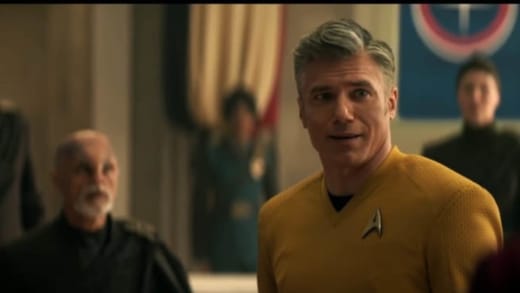
How Does Strange New Worlds Fit Into The Star Trek Universe
The original Star Trek series takes place in 2265, while the Strange New Worlds series starts in 2259. This means the iconic Captain Kirk is not the captain of the USS Enterprise (NCC-1701), which means the current captain will be Captain Christopher Pike .
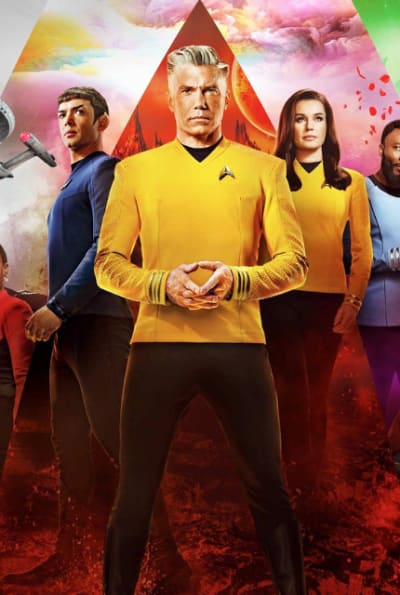
This may be a bit of a change for some Star Trek fans, but it's a good change.
Star Trek's iconic characters from the original series, such as Spock, Scotty, and Nyota Uhura, are also in the Strange New World series.
Some minor characters from the original show also appear throughout the new series, making Strange New Worlds feel like the show was meant to be.
Why is Strange New Worlds The Most Innovative Star Trek Show In Many Years
As the Star Trek: Strange New Worlds series shows us the adventures of Captain Christopher Pike and the crew at the start of USS Enterprise, it will immediately be compared to the original series.
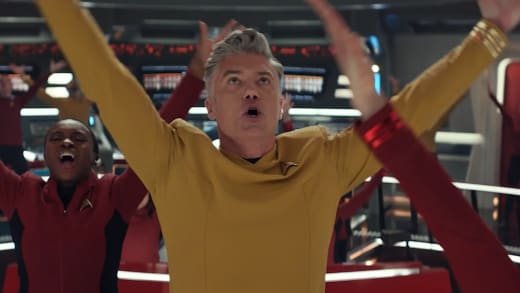
The cast of the new Star Trek show has a compelling story arc, which can make fans of the show feel attached and almost there with them during the crew's many adventures.
The new show takes many elements of the original show, such as the optimism and fun that the crew seems to lavish on.
This does not mean the Strange New Worlds series doesn't have any heart-wrenching moments. The show does have some heavy hitters, as any Star Trek fan knows the fate of Captain Christopher Pike.
Spoiler warning for new Star Trek fans who haven't watched the original series or finished Star Trek: Strange New Worlds Season 1 :
Captain Christopher Pike will die.
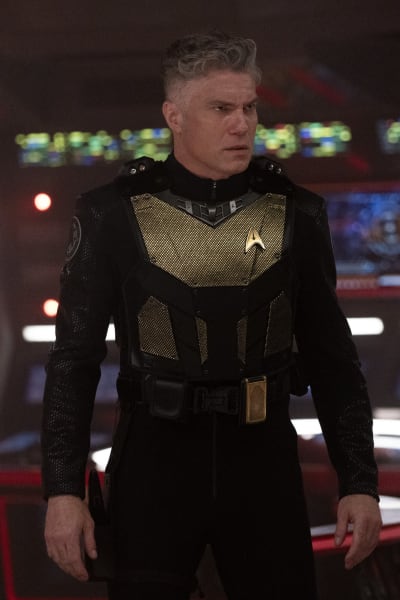
Captain Christopher Pike's death happened in 2266, seven years after the Strange New Worlds series started and two years after the original series.
Christopher Pike dies during an accident while trying to save a handful of trainees on a Class J Starship.
Strange New Worlds doesn't shy away from the fact that Captain Christopher Pike will die; during the show, he learns that he will die and that he has to learn to face his future.
Anson Mount , who plays Christopher Pike in the Strange New Worlds series, gives us one of the best Star Trek captains who has even been in the series.
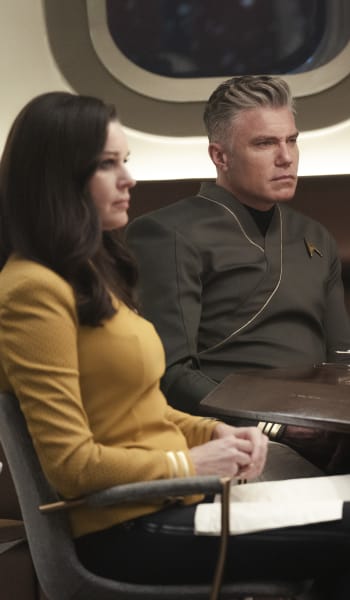
Anson Mount conveys the essence of how a Star Trek captain should act and treat his crew during any situation, even during a stressful situation.
This doesn't mean this captain doesn't break the rules; he just bends them when there is a need to do so.
Another great reason many Star Trek fans hold Strange New Worlds in such high regard is that it is family-friendly.
This alone is why the show is so popular, as families who grew up watching Star Trek can now spread the joy of Star Trek to their children without worrying about any taboo subjects or vulgar words popping up in the episode.
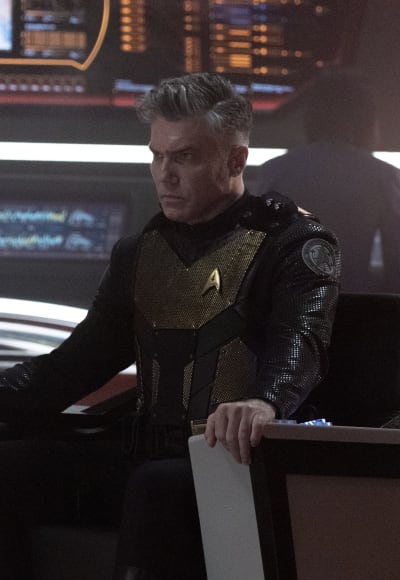
Why Does Star Trek: Strange New Worlds Look So Good?
Strange New Worlds does a great job of using the older elements and designs of the original series while still finding new ways to improve the show's look and feel.
For example, during the Star Trek: Discovery series, the USS Enterprise does make an appearance in the show.
However, the design elements did not match how the starship was supposed to look during the original series.
The latest Star Trek series did a great slight remodel of the starship hull to bring it closer to the original designs while still giving the design a modern feel.
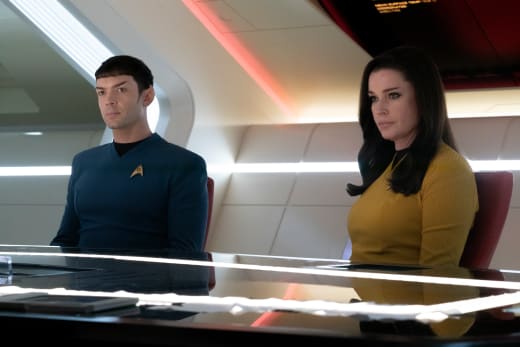
Some fans of the original series may think that the "new" USS Enterprise may look too modern and have lost the charm of the '60s version; this can be seen with the bridge of the Enterprise.
The bridge of a starship in Star Trek is the most important room on all Star Trek shows; this means they are iconic, and many fans know exactly how they look.
The Strange New Worlds creators revamped the bridge with its own elegant and unique design, but it still has many elements of the original set.
The Strange New Worlds series also relies heavily on props and filming sets that help the actors easily immerse themselves in their roles.
This allows the acting and chemistry between the actors to flow naturally.
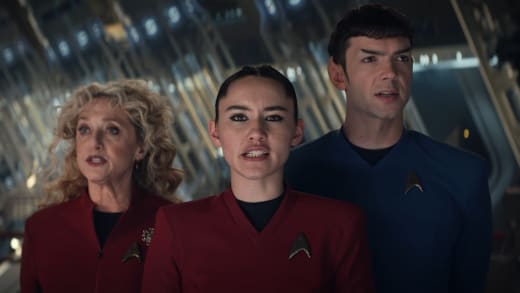
How Will the Show Progress?
As the Strange New Worlds series is a prequel to the original series, there is only so much time before they reach the original series starting date.
But don't worry because this doesn't mean that the show will not have any compelling stories or familiar faces for fans to enjoy.
As the series continues on Paramount+ , we'll surely see some exciting and unique storylines.
What do you think about the two shows?
Is Strange New Worlds truly more innovative than the Original?
Jason Collins is a staff writer for TV Fanatic. You can follow him on X .
Pike: Send someone else. You don't want me in command of that ship. April: You're getting us confused. You don't want you in command. Permalink: You're getting us confused. You don't want you in command. Added: May 04, 2022
No matter how many stars there are in the sky. No matter how many galaxies swirl beyond our own. No matter the mathematical probabilities or the number of times we say, 'We are not alone in the universe,' our first visit from the stars is always the province of children's stories and science fiction. First contact with aliens always lives squarely in the impossible. First contact is just a dream until one day, it isn't. Una Permalink: No matter how many stars there are in the sky. No matter how many galaxies swirl beyond our... Added: May 04, 2022

Star Trek: Strange New Worlds Photos

- February 2024
- January 2024
- 2023 Archives
- 2022 Archives
- 2021 Archives
- 2020 Archives
- 2019 Archives
- 2018 Archives
- 2017 Archives
- 2016 Archives
- 2015 Archives
- 2014 Archives
© 2024 TV Fanatic | About Us | Copyright Inquiry | Privacy Policy | Contact Us
© 2024 TV Fanatic

IMAGES
VIDEO
COMMENTS
Sexism in Star Trek. Publicity photo of Nichelle Nichols and William Shatner ( Trekcore) Star Trek may have been progressive for its time, but it was still a product of the 1960s. This was especially obvious in how it treated women, from Orion slave girls to tiny miniskirts to William Ware Theiss' outfits, which left little to the imagination.
The trope they named in a 'Star Trek' fan zine in 1973 continues to resonate in 2019 ... While the original meaning of a Mary Sue referred to a stand-in ... That includes the creeping sexism that ...
From Jadzia Dax to Adira and Gray, all the times Star Trek has challenged societal gender expectations and binaries. With the exciting confirmation that Discovery is going to be home to new characters, the human, non-binary Adira (Blu Del Barrio), and the Trill trans man Gray (Ian Alexander), it's a good time to examine the legacy of gender ...
A scene from "Star Trek" Everett Collection A fan might assume Roddenberry's personal point of view was noble. The original 1960s NBC series made enormous strides, putting women and ...
Its origins date back to a 1970s Star Trek: The Original Series fanzine, and what caused the concept's inception doesn't align with its current verbiage. Saying "Mary Sue" also doesn't facilitate ...
In the fourth episode of Star Trek: Picard, a familiar face storms onto the scene. With plenty of legacy characters, this might just be another day at the (space) office. But this is Seven of Nine ...
It was, truth be told, an inelegant ending. Star Trek: The Original Series wrapped its run on June 3, 1969 with the episode "Turnabout Intruder," a mad-scientist hour and, in the view of pretty much everyone, a rather sexist installment for such a progressive series.Still, it holds an important place in Star Trek history and, as such, StarTrek.com shares 6 Things to Know About "Turnabout ...
In a recent article in Frontiers, Patricia Vettel-Becker contextualizes the position of female characters on the show and examines not whether Star Trek was sexist, but why it portrayed women the way it did. Star Trek made its debut in the fall of 1966 on NBC. This was its second incarnation; the network had turned down the original pilot for ...
Jarrah Hodge watched all episodes of the first five Star Trek series for The Mary Sue and found that whereas The Original Series had scored a dismal 7.5 percent, almost 45 percent of the episodes of The Next Generation passed the test. (Deep Space Nine and Voyager would do even better, Enterprise did worse.)
Star Trek, the original series, was rampant with gratuitous and thoughtless sexism. Its women were dressed in as little as possible, and if they were not docile, simpering, vacuous sexpots, they ...
Star Trek, Aesthetics, and 1960s Femininity Patricia Vettel- Becker "Oh girls in space, be wary, be wary, be wary!" — as sung by Lieutenant Uhura in "Charlie X" To dismiss the original Star Trek television series, 1966 to 1969, as hopelessly sexist is commonplace, particularly in the many scholarly books and arti-cles devoted to it.
According to Sirtis, she was nearly kicked off the series due to sexism from none other than the creator of "Star Trek," Gene Roddenberry, and only managed to remain on the cast because Denise ...
In the original "Star Trek," the female officers wore miniskirt uniforms, a sexist trope that "Next Generation" tried to take the curse off of by depicting male officers wearing them as well ...
The original intent of that scene was that she was speaking the absolute truth: Starfleet didn't allow women in command. ... Roddenberry later admitted the line was sexist and said he regretted it. However, it was very much in keeping for him. ... so by the time the 1980s rolled around and Star Trek IV showed the captain of USS Saratoga was a ...
But I cannot keep silent about the rampant sexism that has plagued many of the incarnations of Star Trek. Let's begin with the original series, easily considered the most forward-thinking of the bunch as it started the franchise. ... But in many many ways, Star Trek reinforced, not combated, sexism and it's time we laid that on the line ...
But Roddenberry's Star Trek challenged our ideas about race, freedom, leadership, and war. In the original series, he failed to do the same with gender. Women in Star Trek are maidens in distress. Things matured in the rest of the series, but it remained dedicated to the " male gaze ," presenting women on screen for the enjoyment of men.
Turnabout Intruder: Directed by Herb Wallerstein. With William Shatner, Leonard Nimoy, DeForest Kelley, Sandra Smith. Captain Kirk's insane ex-lover Dr. Janice Lester forcibly switches bodies with him in order to take command of the Enterprise.
The times, they are a-changin'.Read the article here: https://whatculture.com/tv/10-most-inappropriate-moments-in-star-trek-the-original-series.#StarTrek #Or...
"Star Trek," now known as "Star Trek: The Original Series," is the one that started it all. The series debuted in 1966 and starred a whole bunch of hotties in skintight costumes, gallivanting ...
Published Mar 20, 2021. Gene Roddenberry's initial concept for Deanna Troi was bizarrely sexual and alien until a fellow writer sat him down. Since its debut, Star Trek has been a platform for progressive stories about humanity, but its history is not without bumps. Legendary creator Gene Roddenberry was the crucial force behind some of the ...
Star Trek is an American science fiction television series created by Gene Roddenberry that follows the adventures of the starship USS Enterprise (NCC-1701) and its crew. It acquired the retronym of Star Trek: The Original Series (TOS) to distinguish the show within the media franchise that it began.. The show is set in the Milky Way galaxy, c. 2266-2269.
Tonight in 1969 — The last original episode of STAR TREK aired on NBC. Credit to the fans, who watched the reruns, bought the toys, read fanzines, went to cons, and kept the franchise alive for a decade until the movies. Archived post. New comments cannot be posted and votes cannot be cast. I think a lot of fans are too much into this episode.
Star Trek: Created by Gene Roddenberry. With Leonard Nimoy, William Shatner, DeForest Kelley, Nichelle Nichols. In the 23rd Century, Captain James T. Kirk and the crew of the U.S.S. Enterprise explore the galaxy and defend the United Federation of Planets.
Can you think of any eye-catching beauties that appeared on Star Trek: The Original Series that went on to have prolific acting careers outside of the franch...
Grace Lee Whitney as Janice Rand, Captain's yeoman. John Winston as Kyle, operations officer. Michael Barrier as Vincent DeSalle, navigator and assistant chief engineer. Roger Holloway as Roger Lemli, security officer. Eddie Paskey as Leslie, various positions. David L. Ross as Galloway, various positions. Jim Goodwin as John Farrell, navigator.
The series is originally set before the events of NBC's original "Star Trek: The Original Series" (later jumping to the future) and follows Michael Burnham (Martin-Green), who became the ...
The Klingons appeared in what was almost a cameo in Star Trek: The Motion Picture, when a small fleet of ships are the first vessels destroyed by the approaching V'Ger. Robert Fletcher, the costumer on The Motion Picture, Fred Phillips, the makeup lead, and Roddenberry each shaped the new look of the Star Trek Klingons.Roddenberry took the idea of forehead ridges that were an extension of the ...
Earth: Final Conflict, created by Gene Roddenberry, had a premise that was the opposite of Star Trek, with humanity being visited by aliens on Earth.; The show faced challenges such as cast ...
STAR TREK: THE ORIGINAL SERIES follows the 23rd century adventures of Captain James T. Kirk and the U.S.S. Enterprise, a powerful interstellar spacecraft dispatched by Starfleet to explore the galaxy and seek out new life and civilizations.
The original Star Trek series takes place in 2265, while the Strange New Worlds series starts in 2259. This means the iconic Captain Kirk is not the captain of the USS Enterprise ...